Express Blog
Ask the Pilot Express is a Semi-Daily Mini-Blog Featuring News Blurbs, Photos, Updates, Random Musings and More.
Subscribe to the EXPRESS RSS
April 16, 2024. High Cuisine.
We all know airport prices can be ridiculous, but where’s the limit?
Here are a couple of delectables to set you back. The first is from Legal Sea Foods at Logan Airport in Boston. The second is from a sandwich place at LAX called Homeboy.


PHOTOS BY THE AUTHOR
April 6, 2024. R.I.P. Air Malta

Another old world carrier has bitten the dust. This time it’s Air Malta, national carrier of its namesake island nation.
Air Malta had been around since 1974, and once flew Boeing 720s across Europe (Google that one if you need to). The company had been floundering for some time, under heavy pressure from low-cost leisure carriers, and shut its doors for good on March 30th.
In its place, taking on most of Air Malta’s Airbus A320s, is a government-run entity called KM Malta Airlines, whatever that means. There’s also a low-cost outfit called Malta Air, in case the name thing isn’t confusing enough.
I don’t like it when flag carriers — to use a vintage expression — go out of business. See Swissair, Sabena, et al. Each time it happens, commercial aviation loses a little more history and dignity, while dumb-named LCCs and startups flood the field.
In 2015 I flew aboard Air Malta, and wrote about the experience in a piece titled, “Long Live Air Malta!”
I did what I could.
March 27, 2024. Tenerife Remembered.
Just a reminder, morbid as it might be, that today marks the 47th anniversary of the deadliest aviation disaster of all time.
On March 27th, 1977, on the Spanish island of Tenerife, two Boeing 747s collided on a foggy runway, killing 583 people. There’s a surreal, almost mythical aura that surrounds the accident, due in no small part to the almost unbelievable cascade of ironies and coincidences that led to it — beginning with the fact that neither plane was supposed to be at Tenerife in the first place.
I was only ten years old, but I clearly remember the day it happened, watching the news in our downstairs living room — the choppy, black-and-white footage from a place I’d never heard of.
March 17, 2024. Crowd Pleasers.
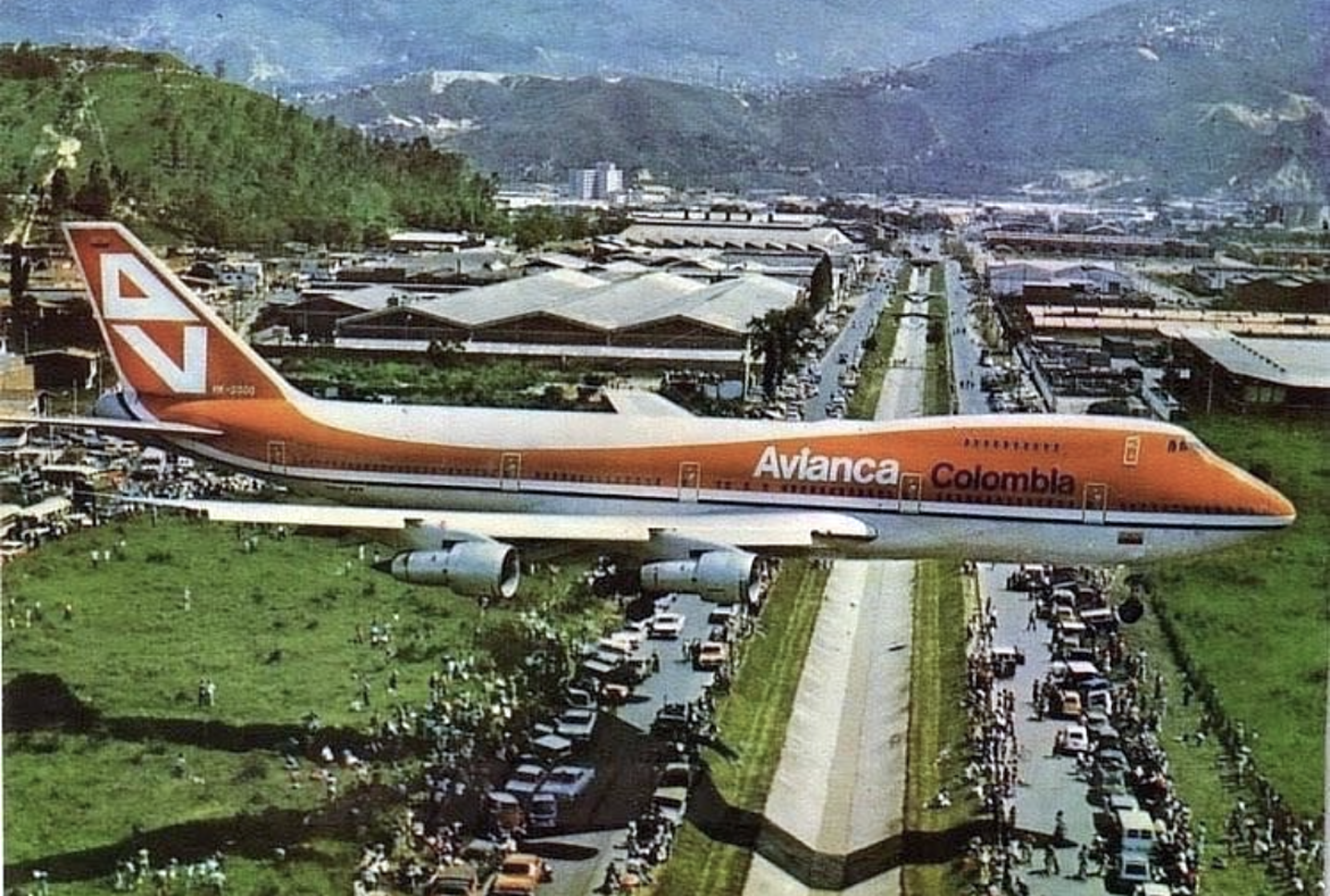
I have this old Avianca Airlines postcard from the 1970s. You can see it above. It’s a picture of the first Boeing 747 to land at Medellin, Colobmbia. What makes the photo so striking are the spectators crowding the roadway at the edge of the airport — a great jumble of cars and people. Hundreds showed up to watch the jet come in.
On Instagram I discovered a similar photo of the first 747 to land in Japan. The caption says that ten thousand people jammed the observation decks at Haneda Airport for the occasion.
And so on. You can find any number of pics like these.
Imagine, today, ten thousand people making their way to an airport just to look at an airplane. It wouldn’t happen, of course. Not even the A380, when it made its debut, got anywhere close to the attention of the Comet, the 747 or the Concorde.
As maybe we should expect. So goes the evolution of technology, no? Jetliners were once a novelty; they aren’t any more. Not even the biggest ones.
Still, we’ve lost something. Beautiful machines that carry hundreds of people around the world at tremendous speeds, and it’s nothing to us. What a strange thing to take for granted.
Photo: Avianca Airlines, from the author’s postcard collection.
February 2, 2024. Slippers.
There’s a lot going on in the airline world: the 737 saga, the blocking JetBlue’s merger with Spirit. Allow me to ignore these stories and talk about something more exciting: airplane slippers.
You know how it goes. You’re on a long-haul trip in first or business, and they give you a pair of those slippers. They’re flimsy and flat on the bottom; you can feel the cardboard insert that forms the sole. After ten minutes, one of them falls off. A few minutes later the other one goes. Later you find them on the floor, lodged somewhere in the footwell. Sometimes, you’re on the way to the lav and the damn things slip off in mid-stride.
We don’t expect carriers to spend much on single-use amenities, but the sad design of the typical inflight slipper makes a cheap and wasteful product only more cheap and wasteful.
One airline has, at last, addressed this. Imagine my delight when I slipped on these new first class Emirates slippers and discovered they include an elastic band that attaches around the heel. A simple, elegant, and (I would guess) inexpensive fix…

How much fun.
Now you can jog your way to the bathroom without a slip; kick your legs around as you toss and turn in your suite; wiggle your toes and shake your ankles. These things stay on.
I swear, this is the smartest thing to happen to premium class air travel in years.
Best of all, you can bring them home and reuse them. They’re still cheap slippers, but they’re good enough to wear into the basement when I have to switch the clothes from the washer to the dryer, or out to the porch for my Amazon packages.
Sometimes it’s the little things.
And this guy could use a pair…

Photos by the author.
January 17, 2024. Desert Desecration.
In a post from a couple of weeks ago, I mentioned the fascinating memorial erected in the Sahara Desert honoring the victims of UTA flight 772, which was bombed in 1989. It was constructed in 2007 in the spot where the plane fell, in the Tenere region of central Niger, paid for using some of the $170 million compensation provided by the Libyan government, which carried out the bombing.
Any number of crash memorials are scattered around the world, and this is maybe the most haunting and evocative of them all. It was built using desert stones, mirrors, and pieces of the wreckage itself, backdropped by one of the most remote and inhospitable landscapes on earth.

It forms a compass rose, with the silhouette of a jet traveling northwesterly — the direction the DC-10 was headed, en route to Paris, when a luggage bomb destroyed it.
Well, I just learned from a reader that the monument was recently vandalized and badly damaged. Nobody knows for sure who did it, but it’s likely the incident is related to last summer’s coup in Niger and the anti-French sentiments percolating within the country.
This is sad to say the least. Desecrating a memorial to the victims of mass murder seems in especially bad taste, and many of flight 772’s passengers were African, not French.
Screen grab from Google Earth
January 2, 2024. Haneda Collision.
UPDATED on JANUARY 5th
Early last Tuesday evening, a Japan Airlines Airbus A350 collided with a Japanese coast guard plane while landing at Tokyo’s Haneda Airport. Most of you have seen the ghastly footage for the A350 skidding down the runway in flames after striking the much smaller de Havilland Dash-8 turboprop. Five people on the smaller plane were killed.
What went wrong, and who’s to blame, will be deciphered in time. For now, the most noteworthy and remarkable thing is that all 379 passengers and crew aboard the JAL plane were evacuated safely. This could have been much, much worse.
And it’s yet another example of why you should never, ever, fuss around with your carry-on luggage during an evacuation. When a plane is ablaze, the difference between life and death — yours or someone behind you — can be a matter of seconds. As we’ve seen in a number of evacuations in recent years, too may people insist on evacuating with their belongings, blocking up the aisles and wasting precious time.
I don’t care what contraband or sex toys you’ve got tucked away in your roll-aboard, or what valuable business secrets are on your company laptop: get the fuck out of the plane and leave your bags behind.
Reportedly, the first PA made to passengers as the JAL jetliner scraped to its fiery stop, was a stern warning to ignore any luggage and get to the exit slides immediately. Well done.
Mostly. One big asterisk is the time it took to get everyone off the plane. The FAA expects a jetliner to be fully evacuated within 90 seconds, even with half of its doors blocked or inoperative. It took over ten minutes for the JAL plane to be fully vacated.
Why it took so long is unclear, and will need to be scrutinized carefully. Was it a lack of urgency? Confusion? Whatever the reasons, it’s unacceptable. and our evacuation protocols may need some revising.
December 27, 2023. Czech Centennial.
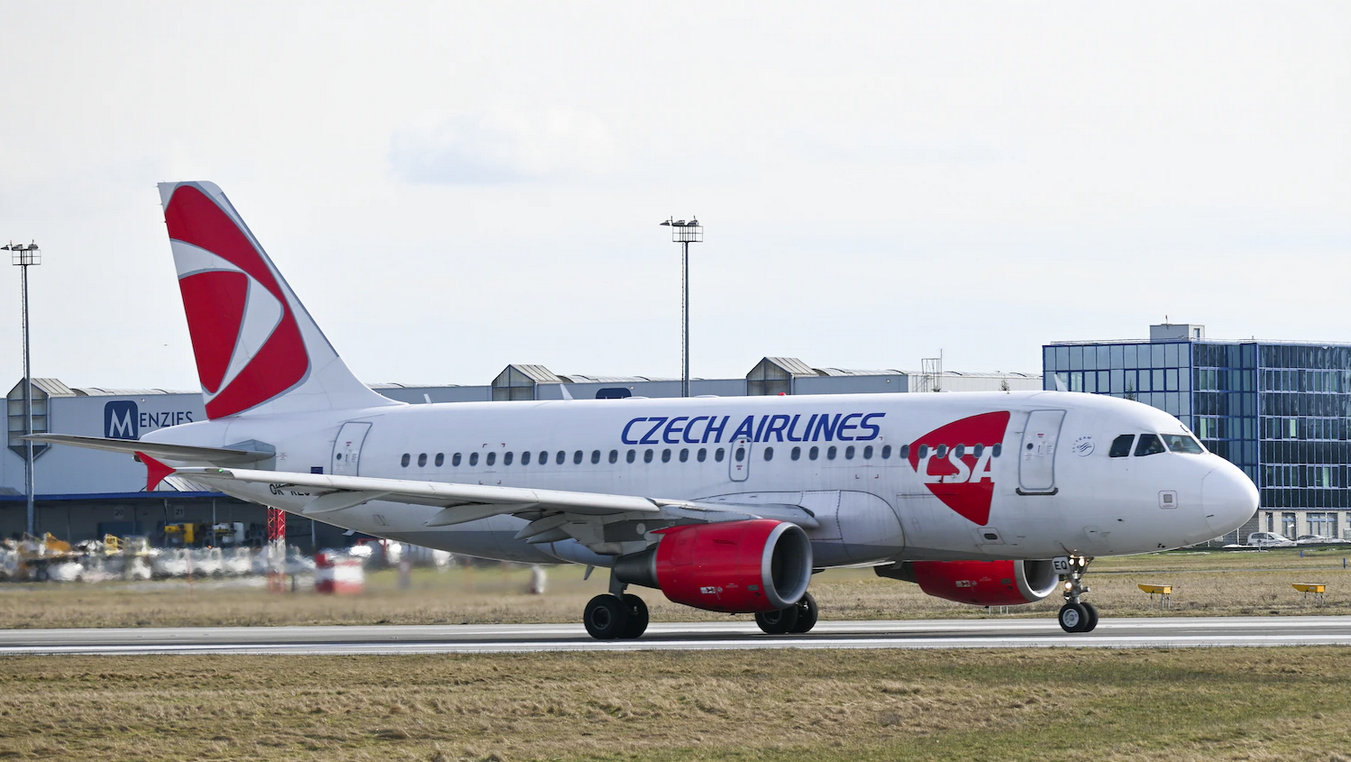
I’m a couple of months late with this, but congratulations to CSA, the flag carrier of the Czech Republic, for celebrating its 100th birthday in October.
Albeit barely. Once a mainstay carrier of Central Europe, with a network reaching the United States, CSA is down to only two airplanes and a handful of destinations. The company survived a 2021 bankruptcy filing, but its future is at best uncertain. Maybe that hideous livery has something to do with it.
Nonetheless, they’ve survived a hundred years, joining KLM, Avianca, Aeroflot and Qantas as the only carriers to hit the century mark. Let’s hope they keep going.
In the days before that atrocious paintjob you see above, the words “OK Jet” emblazoned the tails of CSA’s planes. “OK” is the airline’s two-letter IATA code, and also the aircraft registration prefix of the Czech Republic and former Czechoslovakia. Incorporating this into a tail emblem was equal parts peculiar and charming. The Cold War was maybe more fun than we remember.

Top photo courtesy of Ondrej Bocek and Unsplash.
Lower photo from the author’s postcard collection.
December 21, 2023. Lockerbie at 35
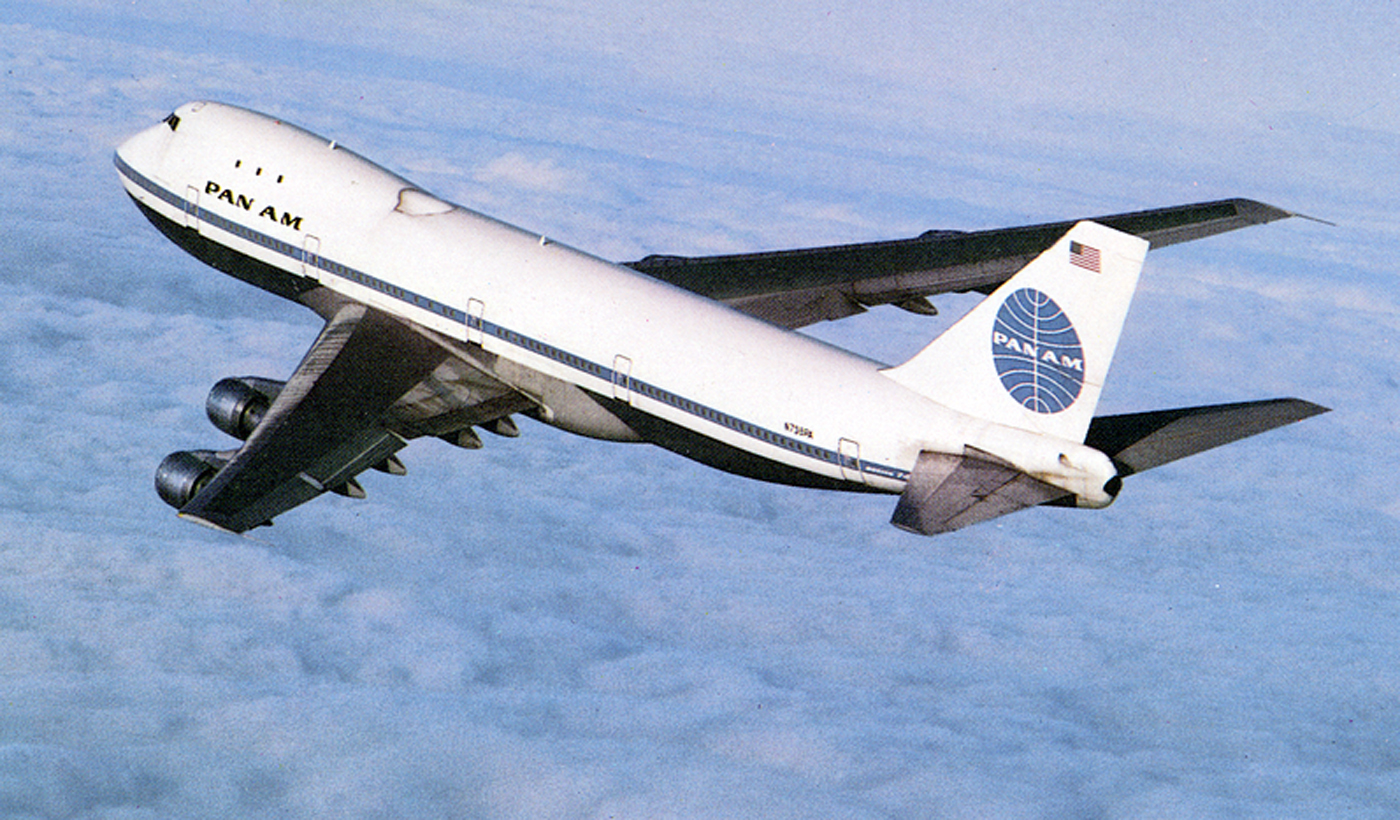
Today, December 21st, is the winter solstice and either the shortest or longest day of the year, depending on your hemisphere. It also marks the 35th anniversary of one of the most notorious terrorist bombings — the 1988 downing of Pan Am flight 103 over Lockerbie, Scotland.
Flight 103, a Boeing 747 named Clipper Maid of Seas, was bound from London to New York, when it blew up in the evening sky about a half-hour after takeoff. All 259 passengers and crew were killed, along with eleven people on the ground in Lockerbie, where an entire neighborhood was virtually demolished. Debris was scattered for miles.
Until 2001, this was the deadliest-ever terror attack against American civilians. A photograph of the decapitated cockpit and first class section of the 747, lying crushed on its side in a field, became an icon of the disaster, and is perhaps the saddest air crash photo of all time.
Two Libyans, Abdelbaset al-Megrahi and Lamin Khalifah Fhimah, were later tried in the Netherlands for the bombing. Fhimah was acquitted, but al-Megrahi was convicted and sentenced to life. The alleged bomb maker, Abu Agila Mohammad Mas’ud Kheir Al-Marimi, was apprehended in December, 2022, and awaits trial.
The government of Mohammar Khaddafy would also be held responsible for the 1989 destruction of UTA flight 772, a DC-10 bound from Congo to Paris. Few Americans remember this incident, but it has never been forgotten in France (UTA, a globe-spanning carrier based in Paris, was eventually absorbed by Air France). A hundred and seventy people were killed when an explosive device went off in the forward luggage hold.
The wreckage fell into the Tenere region of the Sahara, in northern Niger, one of the planet’s most remote areas. (Years later, a remarkable memorial, incorporating a section of the plane’s wing, was constructed in the desert where the wreckage landed.)
Khaddafy eventually agreed to blood money settlements for Libya’s hand in both attacks. The UTA agreement doled out a million dollars to each of the families of the 170 victims. More than $2.7 billion was allotted to the Lockerbie next of kin.
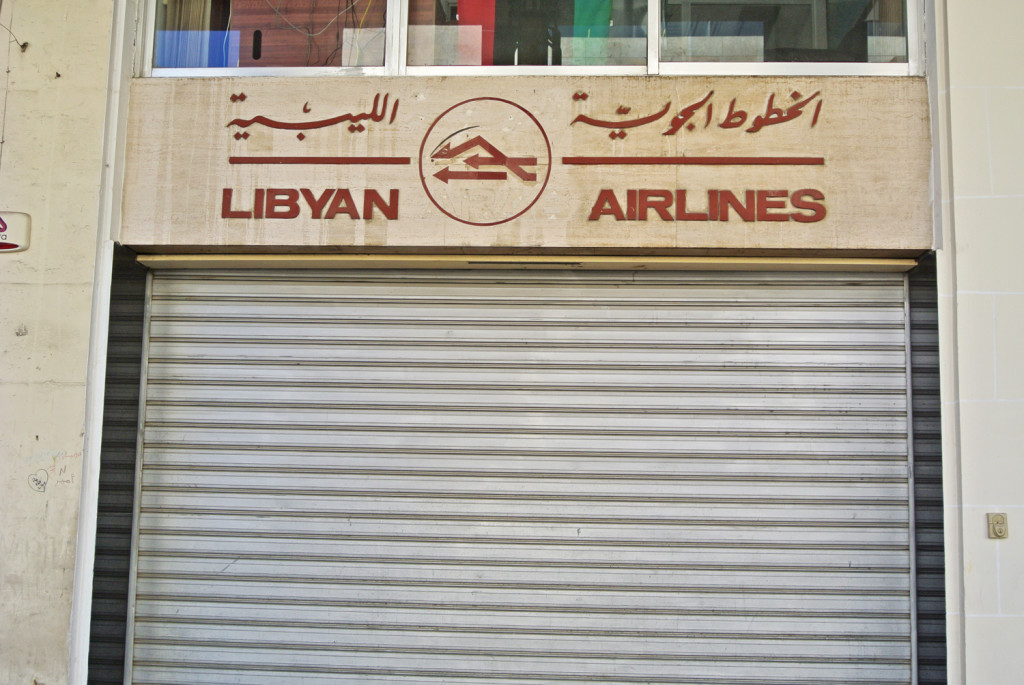
The investigation into the Lockerbie bombing was one of the most fascinating and intensive in history. The U.S. prosecutorial team was led by a hard-nosed assistant attorney general named Robert Mueller (yes, that Robert Mueller). Much of the footwork took place on the Mediterranean island of Malta, where the explosive device, hidden inside a Toshiba radio and packed into a suitcase, was assembled and sent on its way. The deadly suitcase traveled first from Malta to Frankfurt, and from there onward to London.
Both Abdelbaset al-Megrahi and Lamin Khalifah Fhimah had been employees of Libyan Arab Airlines, and Fhimah was the station manager there in Malta. During my vacation to the island a couple of years ago, it was a little eerie when I found myself walking past the Libyan Airlines ticket office, which is still there, just inside the gate to the old city of Valletta.
In 2009, in a move that has startled the world, Scottish authorities struck a deal with the Libyan government, and al-Megrahi, terminally ill at the time, was allowed to return home, to be with his family in his final days. He was welcomed back as a hero by many.
There’s lots to read online about flight 103, including many ghastly day-after pictures from Lockerbie. But instead of focusing on the gorier aspects, check out the amazing story of Ken Dornstein, whose brother perished at Lockerbie, and his dogged pursuit of what really happened. (Dornstein, like me, is a resident of Somerville, Massachusetts, and he lives within walking distance.)
Upper photo courtesy of Pan Am Museum.
Second photo by the author.
November 29, 2023. Logan Lament.

Over the last ten or twelve years, no U.S. airport that has seen more long-haul growth than my hometown airport, Boston’s Logan International. Not that long ago, we had a handful of European routes, some service to the Caribbean, and that’s about it.
How things have changed. Today you can fly nonstop from Boston to Europe, Asia, South America and the Middle East. Pretty much all of the big global players are here, from Emirates to Turkish to Korean. Delta alone has direct flights to nine transatlantic cities, with more planned.
The downside to all of this expansion has been overcrowding and a lack of gates. The only terminal with Customs and Immigration facilities is terminal E, which until recently had fewer than a dozen jet bridges. At the height of summer crowds were unbearable, and long delays were common as planes had to be jockeyed back and forth between the gates and remote parking stands.
And so, when ground was broken for a badly needed terminal E expansion, many of us were excited.
Well, that project is now complete, and I’m sad to say I’m a little underwhelmed. Or confused at any rate. After many months and hundreds of millions of dollars, what we got is only four additional gates.
The new superstructure is enormous. The addition alone is nearly the length of the original building (which, itself, was significantly expanded about twenty years ago). This I imagine — or, I hope — will go a long way towards thinning out those evening departure crowds.
That’s great, but only four gates? With airlines planning more new flights as we speak (just this week Hainan Airlines relaunched its suspended Boston-Beijing service), how much of terminal E’s parking snarl is this going to relieve, exactly?
And no expansion to the Immigration lobby? When I was there a few weeks ago the passport lines were two hours long.
What am I missing? Hopefully this isn’t the usual Boston boondoggle: lots of expensive construction for not a lot of fix.
And, yes, the new extension is very… red. It looks like a spaceship, or the fender of an vintage sports car; retro and futuristic at the same time. It really gives the airport some flair, and I quite like it. I just wish it came with more gates.
Photo by the author.
November 21, 2023. Cold Turkey.
Looking back, holiday flying has provided me a few of those sentimental oddities a pilot files away in his mental logbook:
One of my favorite memories dates all the way back to Thanksgiving, 1993. I was captain of a Dash-8 turboprop flying from Boston to New Brunswick, Canada, and my first officer was the always cheerful and gregarious Kathy Martin. (Kathy was one of three pilots I’ve known who’d been flight attendants at an earlier point in their careers.) The Dash-8 had no galley, but Kathy brought a cooler from home packed with food: huge turkey sandwiches, a whole blueberry pie and tubs of mashed potatoes. We assembled the plates and containers across the folded-down jumpseat. The pie we passed to the flight attendant, who handed out slices to passengers.
Quite a contrast to Thanksgiving, 1999, when I was working a cargo flight to Brussels. It was the custom on Thanksgiving to stock the galley with a special holiday meal. The three of us were hungry and looking forward to it. The trouble was, the caterers forgot to bring the food. By the time we noticed, we were minutes from departure and they had already gone home for the day. We always checked the galley prior to leaving, and I thought I might cry when I pulled open the door and saw only a can of Diet Sprite and a matchbook-size packet of Tillamook cheese.
After a desperate radio call to ops, one of the guys upstairs drove out to McDonald’s and came back with three greasy bags of burgers and fries. Who eats fast food on Thanksgiving? Pilots in a pinch.
Just a few years ago I spent most of Thanksgiving day on board a Qatar Airways A350 en route to a vacation in Armenia. Thanksgiving is unknown outside the U.S., but Qatar featured an autumn-themed holiday menu that day in business class. A nice touch, I thought, and something I wish our own airlines did.

October 26, 2023. 707 Remembered.
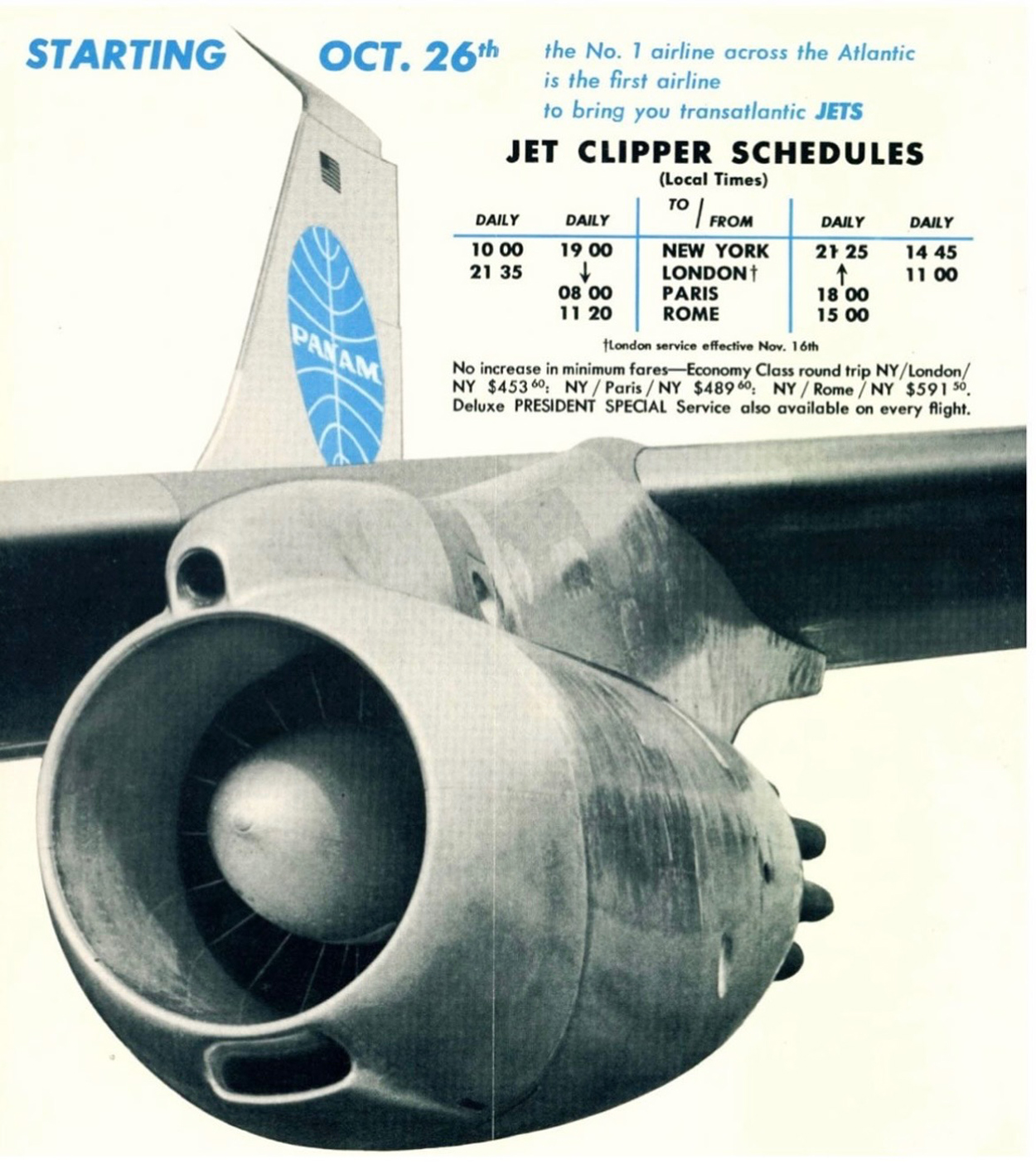
Today marks the 65th anniversary of the Boeing 707’s entry into commercial service. The 707 was America’s first jet, launched by Pan Am on October 26th, 1958, between New York’s Idlewild Airport (JFK today) and Le Bourget Airport in Paris.
Debut of the 707 wasn’t as momentous or revolutionary as the 747 would be twelve years later, but it was certainly a milestone. Passengers could now fly at double the speed, and double the comfort, than they could in any propeller-driven plane.
The Brits had been first into the Jet Age with the de Havilland Comet. The Soviets then followed with the Tupolev Tu-104. But the Comet was tragically beset by a series of crashes and withdrawal from service, and the Tupolev was, well, a Tupolev. So while the 707 was actually third in line, it became by far the most successful of the new jets, quickly changing the face of air travel.
As you can see from the graphic, in 1958 an economy round-trip ticket from New York to Paris cost $489. That’s over five-thousand dollars in today’s money. The advent of jets — particularly the 747 later on — would make long-haul flying affordable to millions of people, but cheap mass travel as we know it today was still decades away.
The Boeing 737 still uses the same nose-section architecture of the 707. Those old-fashioned looking cockpit windows you see on a brand-new 737 MAX look that way for a reason: they’re a nearly 70 year-old design.
October 14, 2023. Africa Deluxe.
This site has been quiet lately, I know.
The first reason is that I’m lazy. The second reason is that I’ve been on vacation. Below are two photos taken last week in Tanzania. Pardon the diversion, but in lieu of anything aviation-related, readers are invited to check out my Instagram stream view my latest travel photos.


September 19, 2023. Going Around.
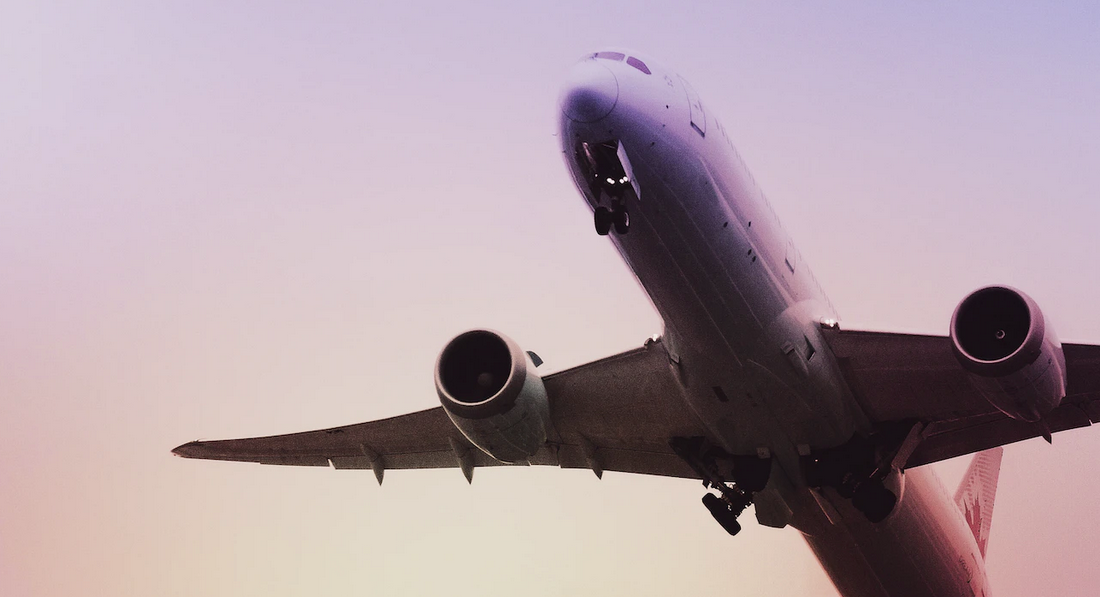
Here in Boston the other day, a United Airlines jet performed a go-around just prior to landing due to a non-critical traffic conflict. That’s when a plane, at some point prior to touchdown, breaks off its approach and zooms up again. “Aborted landing” is a sometimes-used term that means the same thing.
The incident made the local news because… well, just because. Passengers “gasped,” according to FOX 25 News, which ran both online and TV segments about the incident.
I say “incident,” but only for lack of a better word. Go-arounds can be unsettling for nervous and even non-nervous flyers, but I can’t overemphasize how routine the maneuver is for pilots. And as I’ve written before, the transition from descent to ascent, however abrupt, is perfectly natural for an airplane. The noises and sensations make a go-around feel a lot scarier than it is.
Neither are most go-arounds performed in response to some imminent danger or catastrophe. I notice the FOX story contains this line: “When a go-around occurs, the air traffic controller and pilot are said to be working together to ‘prevent an unsafe condition from occurring.’”
That’s a direct quote from my book, by the way, and from an earlier post on this site. They obviously saw it, but didn’t attribute it for some reason. They used the “said to be,” to avoid citing me directly. The reporters, to their credit, make a decent effort to point out the harmlessness of go-arounds, but the fact this was a news story at all is, for a pilot, a little annoying.
I’m typically at the controls for a go-around once a year or so, on average. That doesn’t sound like a lot, but the maneuver is straightforward and we practice them all the time in the simulator.
RELATED STORY:
Photo courtesy of Patrick Tomasso/Unsplash.
August 30, 2023. Rolling On.

Yeah, this again.
I’ve written before of my disdain for use of the term “roller boards” (or the compound, “rollerboard”) in describing wheeled carry-ons. I’ve been hearing this lazy mispronunciation more and more, usually from flight attendants: “Ladies and gentlemen, please place your roller boards into the bins handle-first.” My what? We picture a wooden plank with wheels on it, or a surfboard strapped with roller skates.
What they’re meaning to say, of course, is roll-aboard. It’s a carry-on with wheels; you roll it aboard. This shouldn’t be difficult.
Well even airlines are using the garbled version now, as the photo above shows.
I worry this battle is lost.
Related Stories:
DAMN THE SPINNER BAG.
ET TU, GARY SHTEYNGART?
Photo courtesy of Hesh Lee.
August 28, 2023. Medical Records Controversy.
You may have seen the articles this week about the pilots suspected of concealing medical issues from the FAA. Airlines pilots undergo twice-yearly medical evaluations in order to maintain flight status, and some of the criteria relies on self-reported visits to doctors or other health professionals. As many as 5,000 former military pilots may have neglected to report certain treatments — the same treatments they were simultaneously receiving benefits for through the Veterans Administration. And, apparently, most of the concealed incidents involve mental health issues.
Let’s face it, the flying public doesn’t want to hear the words “pilots” and “mental health” in the same sentence. But a pilot seeking assistance with a stress or anxiety issue — or even for depression — is not by definition an unsafe pilot or one that’s a menace to the traveling public. As I stated in a prior post, the idea that a depressed individual, or one otherwise seeking treatment for any mental health problem, is likely to be a dangerous individual, is an ignorant and unfair presumption about the nature of mental illness. And the fact is that people in any line of work are sometimes in need of help, including those with lives in their hands, be they pilots or neurosurgeons or subway drivers or anyone else. Because this story involves pilots is not a reason to sensationalize it.
Frankly, I’m a little surprised by the news, because the FAA has grown a lot more progressive when it comes to pilots and mental heath. Most conditions and treatments do not mandate automatic grounding; even certain anti-depressants now are permitted, albeit under a supervised regimen. Airlines, too, have worked hard to to de-stigmatize the issue, encouraging employees to seek whatever help they need. Similar to the successful HIMS program dealing with alcoholism, it’s a proactive approach that is safer in the long run than scaring workers into hiding their problems.
There’s always the possibility, it hardly needs saying, that this controversy is less about mental health than about individuals cheating the VA to collect benefits. At which point it becomes a different conversation entirely.
Either way, each case will need to be looked at individually. I suspect — and this is wholly my hunch — things aren’t as scary as the media makes them sound. Worst case, it was likely pilots acting out of embarrassment rather than hiding unsafe conditions. That stigma might be tougher to break than expected.
For more, see my earlier article, below…
Related story:
PILOTS AND MENTAL HEALTH
August 21, 2023 Near-Miss Hysteria?
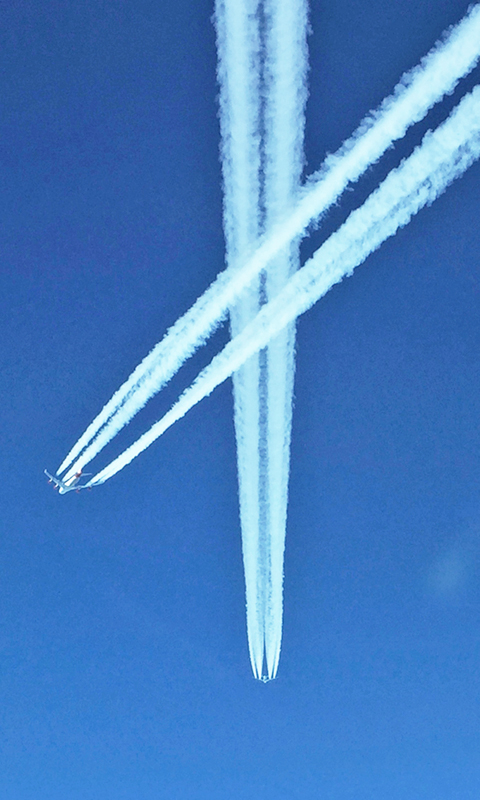
Just a quick comment on this week’s New York Times article about the uptick in near-collisions between commercial jets, both aloft and on runways.
The story is alarmist in spots, but overall it’s not wrong. The dynamics are pretty simple: we have increasingly crowded skies and a heavily understaffed air traffic control system. In no way is this a healthy combination.
Still it’s not as scary as it seems. The most important thing to remember is that more planes are flying than ever before. Thus it stands to reason that the number of near-misses or runway incursions will be higher than it used to be. The critical stat, which is obscured by other data, some of it anecdotal, is how many incidents, and of what severity, we are seeing per departure. Is this number up or down? I don’t really know. The article itself acknowledges that it’s unclear to what extent a higher number of incidents is due to better data collection, while FAA statistics show no significant change in the frequency of on-the-ground runway incursions over the last several years.
If, worst case, we are less safe, statistically, bear in mind that less safe and unsafe are different things. I fly for a living; I’m in the air all the time. Am I concerned? Absolutely. And the fact that we allowed our ATC system to become so understaffed is a national shame. Yet another case of terrible decision-making induced by COVID. But do I feel the skies are unsafe, or that a catastrophe is imminent? No.
Beware, also, of terms like “near miss.” This is a subjective expression that can mean different things, most of which aren’t as frightening as the words imply.
Lastly, while the threat of ground collisions is a tougher problem to tackle, an airborne collision is an extremely unlikely event. Modern commercial planes are equipped with sophisticated anti-collision technology, which is always there as a safeguard in the event of an air traffic control error.
Contrails photo by the author.
June 16, 2023. Going Paperless.
Emirates has announced they’re eliminating paper boarding passes. Passengers will now rely on a digitized version on their smartphones.
Expect other carriers to follow. You’ll be told this is intended to make the check-in and boarding experience easier. You might hear the word “streamlined.” In reality it makes it more cumbersome and annoying. It’s up there with restaurants using QR codes in place of traditional menus. Instead of relying on the simplicity and and user-friendliness of something tangible, we now have to fumble with our phones.
As most travelers are aware, digital boarding passes already are a thing. But at most airlines the option for a hardcopy pass remains, and in many situations is preferable.
Then there’s the sentimental aspect of it. I’ve always loved the heavier, cardboard boarding passes used on many long-haul flights, and I’ve kept them as souvenirs. Many flyers do the same — the way people save ticket stubs from concerts and other memorable events. They’re keepsakes. Not being able to do this any more is another small way of making the air travel experience less special.
First went the boarding pass wallet. Now goes the pass itself.

Photo by the author.
Related stories:
THE POST-PANDEMIC HOTEL ROOM
HOMAGE TO THE BOARDING PASS WALLET
May 31, 2023. Departure Wing.
Airport art, and there’s a lot of it these days, can be hit or miss. We applaud any attempts to make the passenger’s experience a little less tedious and austere, but most of it, lets be frank, is just filling space.
One soaring exception is “Little Wing,” a piece by California artist Krysten Cunningham. It’s part of the LAX Art Program, and can be seen in Los Angeles in terminal 3, just before the security checkpoint. The feather-pattern wing shapes are formed by a geometric lacing of white rope set against a sky-blue background.
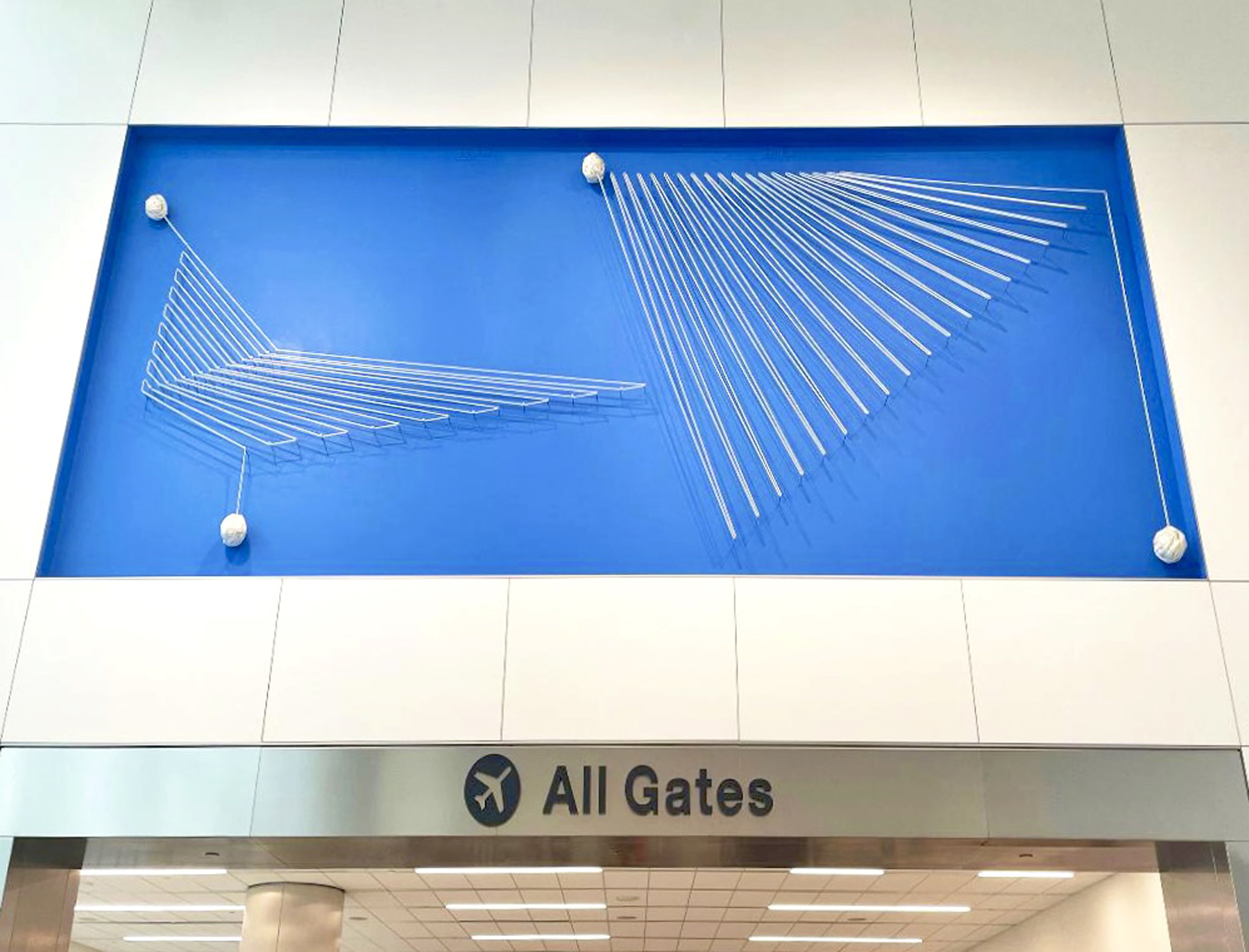
It’s bold and clever and handsome, evocative of flight while avoiding cliche. I’ve seen a lot of airport art in my travels, and this is my favorite piece thus far. It’s scheduled to be in place until 2024. They should leave it up for good.
Photo by the author.
April 1, 2023. Great Moments in TV History.

If you’ve seen the new Netflix documentary about the MH370 mystery, maybe you caught my three-second nonspeaking cameo. It’s in the first episode, maybe about halfway through. It’s momentary footage from an old CNN interview back in 2014. I appear on a split screen with three other talking heads.
No, not the handsome Jeff Wise on the right, or Piers Morgan, on the left, who was asking the questions. I am the one with no hair, two chins, the bile-colored shirt and a look of angry exasperation. More of a scowling head than a talking one. I don’t remember the conversation, but I was obviously annoyed by something. My facial gestures are hilarious. I appear twice, for just a second or two each time.
As to the show itself, I couldn’t get past episode two, with all its conspiracy-theory nonsense. If you wanna know what I think about the missing flight, try the links below…
Related Stories:
March 27, 2023. Senegal Redux.
This past weekend I was back at the Pullman hotel in Dakar, Senegal, for the first time in a decade. (The Pullman — specifically its old room service menu — makes a cameo in chapter four of my book, some of you might recall.) It was mostly the same as I remembered, except for one thing.
As in the old days, we all got rooms on the east side of the building. Riding up the elevator I was excited, remembering those wonderful views of the harbor and Goree Island. But a surprise was waiting.
The top photo shows the view from my room in 2009. The lower photo shows almost the identical view in 2023. Speaks for itself. Progress or something.


The curved building with the triangular top is an old property that I once nicknamed “the Graham Greene Hotel,” because it reminds me of the sort of place where the famous novelist would have stayed, making journal entries in a sitting room with potted palms and a ceiling fan. I was pleased to see it’s still there, and looks like it’s been renovated.
March 27, 2023. Tenerife at 46.
With so many runway incursions in the news, it’d be remiss of me (or else a gesture of the poorest taste) not to mention that today marks the 46th anniversary of the collision at Tenerife — the worst disaster in aviation history.
I was only nine at the time, but I remember my father calling me to the TV as the news showed grainy footage from an island I’d never heard of.
Related story:
March 8, 2023. Pacific Plunge.

In mid-December, a United Airlines 777 descended rapidly towards the Pacific Ocean shortly after takeoff from Maui, Hawaii, coming less than a thousand feet from the water before safety climbing away again. The incident was under investigation by United and the FAA, but otherwise hadn’t garnered much attention. Then the media got wind of it, and now it’s everywhere.
To this point I’ve avoided any commentary or statements. The lack of hard info makes speculation and conjecture risky. Even in pilot circles little is known. But considering the level of hype this story is getting, I should probably say something. So here it is:
The rumor going around — again, it’s a rumor — is that the pilots went directly from flap setting 20 to flap setting zero (up) just after takeoff.
Normally, the flap and slat retraction sequence takes place in increments, as you accelerate during climb. Hitting a certain speed, the flying pilot calls for the next position. The monitoring pilot then verifies the correct speed and acceleration, and brings the flap lever to the proper setting.
The takeoff flap setting in a 777-200 can be 5, 15, or 20, depending on runway length, weight, and other factors. As a ballpark rule, the shorter the runway, the higher the setting. Less runway equals more flaps, in other words, to help the plane generate as much lift as possible in the shortest time.
Flaps 20 would be the expected setting for takeoff from Maui, where the runway is stubby. The plane would lift off at a relatively low speed, then accelerate through a series of “gates” during which the flaps are brought up in steps. Going straight from 20 to zero would suddenly leave the plane in severe danger of stalling. And if that’s what happened, we presume the “dive” toward the ocean was the crew’s attempt to gain speed and protect themselves from a stall. The correct move, in that circumstance. Perhaps the flaps were re-extended as well; we don’t know.
Indeed, we don’t really know anything. Whether things happened as described, I have no idea. This scenario — or some similar version of it — is certainly possible, but it’s hearsay at the moment. If things did occur as described, and the pilots bypassed the normal retraction sequence, the question is why. It surely wasn’t intentional. A misunderstood command, maybe, compounded by the second pilot’s failure to verify? Something like that?
Meanwhile, a different rumor describes a significantly different chain of events, this one involving an incorrectly set altitude window and subsequent VNAV mode activation… It gets technical; I won’t bore you with the details. From what I’ve been hearing, the investigators’ main focus is on a breakdown in crew coordination. What that means, exactly, remains to be seen. We’ll have the whole story eventually.
Photo courtesy of Unsplash
February 10, 2023. Aeroflot Centennial.

We’re not supposed to say nice things about the Russians these days, but congratulations to Aeroflot. The Russian carrier celebrated its 100th birthday last week, and joins the short list of airlines (KLM, Avianca, Qantas) to hit the centennial mark.
Most people don’t remember that in its ’60s and ’70s heydays, Aeroflot was by far the largest airline in the world, carrying roughly as many passengers as all of the U.S. majors combined. With the breakup of the Soviet Union it fragmented into dozens of independent airlines, but a core Aeroflot was kept intact, and it remains today the de-facto national carrier of Russia. It’s not the airline it used to be, but a hundred years is a hundred years. So happy birthday to one of history’s oldest and most storied airlines.
What I love best is that they’ve maintained their beautiful, communist-era hammer and sickle logo. Sure it’s anachronistic, but it’s a classic. “Iconic” is one of the most overused English words these days, but here it’s apropos.

I flew Aeroflot on a couple of short routes — Helsinki to Moscow, and then up to Leningrad — in 1986. These were still Soviet times, and the planes were Tupolevs. I have no photos from those flights because passengers weren’t allowed to use cameras.
Russian fleets are predominantly Boeings and Airbuses these days, but in earlier decades it was all Soviet jets. The design bureaus of Andrei Tupolev, Sergei Ilyushin, and, down in Ukraine, Oleg Antonov, produced a variety of prolific models, a few of which are still flying.
The old Soviet planes are usually described as knockoffs of Western jets, but this is only somewhat fair. The three-engine Tu–154, for example, was a 727 doppelgänger; then again, the 727 was itself styled on the De Havilland Trident. It could be hard to tell who mimicked whom.
Guilty as charged, though, when it comes to Tupolev’s Tu-144, a.k.a. “Concordski.” The mantis-like –144 beat out the Anglo/French Concorde by two months to become the world’s first supersonic commercial aircraft, and its development is a wild tale of Cold War espionage complete with Concorde specs smuggled into Russia by train, concealed in toothpaste tubes. Faster and bigger than Concorde, the –144 began flying cargo missions in 1975, then later carried passengers on the always glamorous Moscow-Alma Ata pairing. Though quickly withdrawn from service, it flew research missions into the 1990s.
Postcard (top) from the author’s collection.
January 31, 2023. Jumbo Finale.
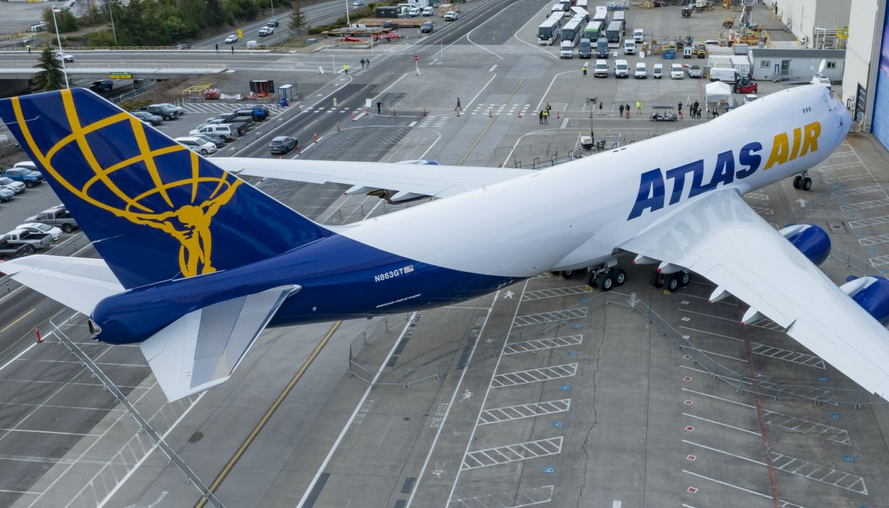
Earlier this week in Everett, Washington, the final Boeing 747 was delivered.
I’d been invited to attend the ceremony, but a prior commitment kept me away. Which is maybe just as well, since I find the whole thing pretty depressing. Seems more like a funeral than anything to celebrate.
The 747 was Boeing’s greatest achievement — indeed it was one of the greatest achievements in the whole history of American industry. Boeing has long since lost its way, and there are those who doubt the planemaker will survive long term. To think, the company that conceived something as legendary as the 747 hasn’t designed a truly new airframe in thirty years, and is apparently content churning out 737 derivatives until the end of time.
The final plane was delivered to Atlas Air, a New York-based cargo carrier that is the world’s largest operator of 747s. The plane, registered N863GT, wears a decal near the nose honoring Joe Sutter, the Boeing engineer who ran the 747 design team.
There isn’t much I can say about the 747 that I didn’t say here, in 2018, when the jet celebrated its 50th birthday. It’s nothing if not the most influential and historically significant airliner of all time. And also one of the prettiest.
The 747 entered service with Pan American on January 21, 1970. The Atlas Air jet delivered on Monday was number 1,574 of a production run that spanned five decades. Of the 27 original customers, Lufthansa is the only one still flying them.
When it debuted, the 747 was more than double the size of any existing plane. Yet it was conceived (literally on the back of a napkin), designed, built, and flown, in a period of only two years. Of all its accomplishments, milestones and accolades, that one might be the most startling.
I flew aboard the 747s of Pan Am, El Al, British Airways, Air France, Northwest, United, Delta, South African, Royal Air Maroc, Singapore Airlines, Qantas, and Thai Airways. I’d like to add a few more to that list while I can.
Related Stories:
THE 747 IN WINTER
A LIFE LIST OF PLANES
Photo credit: Paul Weatherman/Boeing
November 28, 2022. The MAX is Back.
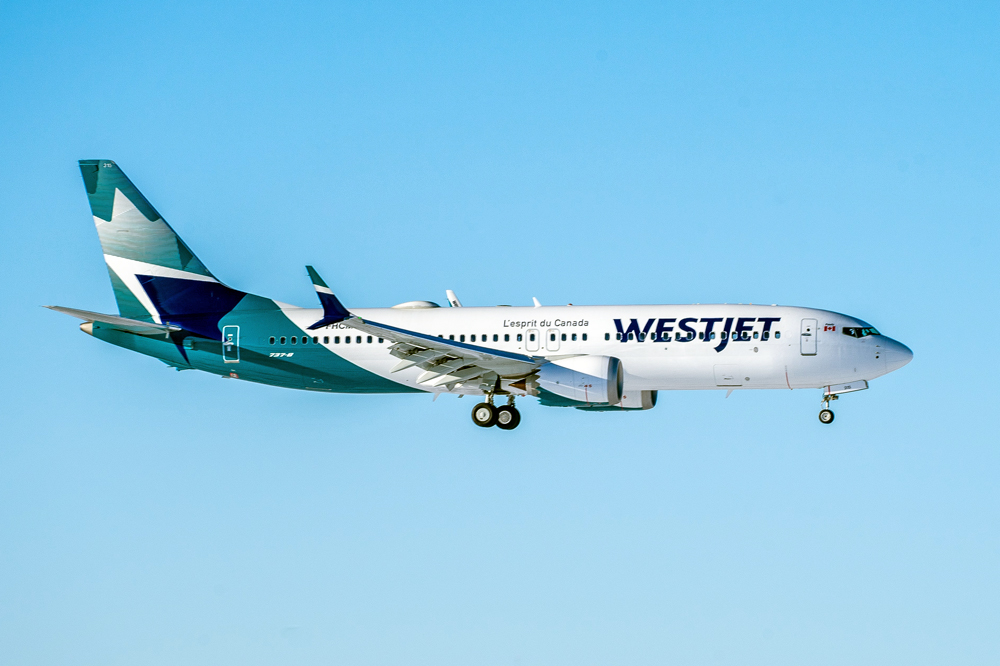
Boeing 737s are everywhere. Notice, though, the ones with the particularly ugly winglets and the scalloped engine cowlings. Those are the 737 MAX variants.
If that name rings a bell, it should. The MAX was the jet involved in two notorious crashes — the Ethiopian and Lion Air disasters — after which it spent two years on FAA-mandated hiatus, during which its twice deadly stall-avoidance system was redesigned, and pilot training protocols modified. The jet re-entered service in November, 2020, and has since settled in without any hiccups. And without much notice, for that matter.
The purpose of this post is to gloat: I told you so. If only I had a dollar for every time someone insisted the jet would never be back. Or, that if it did return, passengers would refuse to step aboard. Which was nonsense from the start — that second part especially. The vexed legacies of the Comet, the DC-10, and even the 787 attest to the flying public’s willingness to forgive, forget, or both. This was no different. As I predicted would happen, that earlier anxiety has evaporated, and nobody, best I can tell, is acting afraid.
Which is fair enough. There’s no need to avoid the MAX.
I’m no fan of 737s, but my reasons aren’t related to safety. I flew a MAX from Miami to Medellin, Colombia, about a year ago. What concerned me wasn’t the possibility of crashing, but discovering that American Airlines has no entertainment screens even in first class!
Related Stories:
BOEING’S BELEAGURED MAX HEADS BACK INTO SERVICE
THE PLANE THAT NEVER WAS
October 13, 2022. Instagripe.
You’ve done a good job staying clear of the whole social media thing. But then your agent says, in that tone of hers, “You really ought to join in.” If only for promotion, she says. It’ll help sell the book. It helps promote the site. Gets your name out there, wherever there might be. And all that.
And so, late to the party as usual, Ask the Pilot now has an Instagram feed. Is that the right word, feed? Channel, account, timeline… whatever you call it, it’s there, and you’re invited to subscribe.
Most of the photographs will be travel-oriented, though plenty too will be of and from airplanes and airports, plus my normal diversions into music, etc. Click the icon or search for ASKTHEPILOT.
We already went through this with Facebook and Twitter, you might recall.
On Facebook you’ll find two pages. The first is the official Ask the Pilot fan page (can it be a fan page if the author himself is creating it?). In addition to the latest posts and stories, it features photos and tidbits that aren’t part of the ATP site itself. The second page is my personal page. This one is for friends, family, and my more devout and obsessive groupies.
Lastly is Twitter, from where I normally tweet links to the newest stories.
April 13, 2022. The Iranian Griffin.
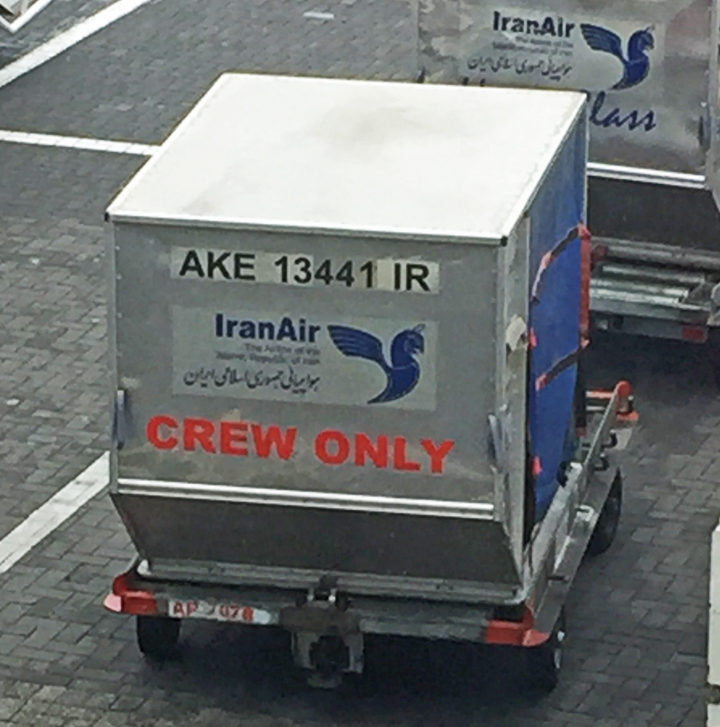
Man, deadheading Iran Air crews really have it tough. It must get claustrophobic in there. (Photo taken at Amsterdam-Schiphzl.)
Very funny. That’s not for the crew, of course. It’s for their luggage. Outside the United States, air crews embarking on multi-day assignments travel with large, hard-side suitcases, which they check in prior to flight. The bags are then loaded into designated containers like this one. Hauling a week’s worth of clothes around in a roll-aboard bag is mostly an American thing.
Iran Air’s peculiar logo is inspired by the character of Homa, a kind of bird-horse-cow griffin, seen carved on the columns at the ancient Persian site of Persepolis. The symbol was designed 1961 by a 22 year-old Iranian art student named Edward Zohrabian, and has been used ever since. It’s an old-fashioned design for sure. It’s also vaguely fetal and creepy-looking. But here’s hoping they keep it, if only for posterity. It’s just a matter of time, I worry, before this enduring mark is dustbinned for some stupid swooshy thing.

Related Story:
February 7, 2022. New Look.

After a long delay, I’ve at last gotten around to introducing a new logo. Refresh your browser, and behold.
Try not to hate on it. If you find it unexceptional, remember that I subscribe to the belief, espoused by more than one famous designer, that a truly effective logo must be unencumbered enough for a child to draw freehand, from memory, with a pencil. It should not rely on colors, textures, or complicated details. Hence the simplicity.
Regular readers know of my disdain for the “swoosh” motifs that have become so commonplace in modern branding. Hopefully that circular arrow isn’t too much of a violation. It’s a swoosh, I guess, but it conforms to the above rules and doesn’t feel gimmicky to me.
I wanted to stay with the basic elements of the original logo: the arrow, the globe, the plane. The arrow and the globe suggest travel. The plane is a plane, though you’ll notice I replaced the generic propeller version with a 747 silhouette — because of course I did. There’s no “official” color for the mark. It looks good in gold, white, black. It’ll often be set against a navy blue field, as that’s the background color of the website, but the pattern itself is the important part, not the colors.
Now I can finally get some hats and t-shirts printed up.
I had nothing to do with the old logo. It was assigned to be by the editors at Salon.com twenty years ago, when I began writing a column for that magazine. I have no idea who created it. Salon also conceived the “Ask the Pilot” name, which I confess I’ve always despised. I might change that too, if the right replacement came along.

February 1, 2022. Winter Skid.
This past weekend’s storm carried me back. Back to 1982, and the Saturday night when a World Airways DC-10 skidded off the end of a runway in Boston.
It was January 23rd. The flight, with 212 people aboard, had originated in Oakland, California, with a stopover in Newark. At 7:36 p.m. the plane landed on Logan International Airport’s runway 15R — the airport’s longest stretch of pavement. The weather was neither stormy nor especially cold. In fact, it was 38 degrees with light rain. The runway, though, was covered in hard-packed snow from an earlier storm, which had turned the accumulating rainwater into a frozen glaze. The plane landed long and fast, missing the intended touchdown point. A braking report, some two hours old, rated the runway braking action as “fair to poor.” In truth it was “poor to nil.”
Unable to stop, the plane rolled past the end of the runway, veered to the right, then lumbered down an embankment into a shallow section of Boston Harbor. The forward-most section of the fuselage, including the cockpit, galley, and the first row of seats, broke off and fell forward, filling with icy water. There was no fire, however, and at first it was assumed that everyone had survived. It wasn’t until three days later that authorities realized two passengers were missing.
The missing people were Walter and Leo Metcalf, a father and son from Dedham, Massachusetts. They’d been sitting in the section that had snapped off and become submerged. The Metcalf’s bodies were never found, and to this day some believe they faked their deaths as part of an insurance scam. More likely, the two men, neither of whom could swim, were swept out to sea by the tide.
Two days after the crash, on Monday, I was at the airport, flying to La Guardia with my mother on the Eastern Shuttle. I was in tenth grade. I had a window seat, as always, and as our A300 taxied along the perimeter, I could see the red, white and gold DC-10, its nose section broken cleanly away, as if cut with a saw, still sitting there in the harbor. They had already covered over the “World Airways” titles with a tarp.
Forty years and millions of landings later, the Metcalfs are still the last airline passengers to die in an accident in Boston.
World Airways, founded in 1948, was predominantly a charter carrier, but had been trying to get a foothold in the scheduled services market. This didn’t last long, and the company went back to its roots, offering passenger, cargo, and military charters that spanned the globe. World went out of business in 2014.
Related story:
December 3, 2021. Odd Angles.

This photo, snapped at LAX, shows a segment of that airport’s Tom Bradley Terminal. Now, I’m all for architectural flourish, but this manic convolution of angles makes my head spin. Have you ever seen such a complicated design?
The interior of the Bradley is equally disorienting. Arriving from overseas the other day, we endured an incomprehensible series of ups, downs, lefts, rights, switchbacks and escalators before finally reaching the immigration hall.
This is not unusual. I had a similar experience at Miami a couple of months ago. The journey — and it was very much a journey — from jetway to the passport kiosk was like finding one’s way through a topiary maze.
Why? Why are so many airport buildings constructed like this? Is it simply to drive the price up?
Strikes me that airport terminals should better resemble railway terminals, with a large central hall and offshoots for boarding and deplaning. Organized and simple, with a minimum of twists and turns. Such a blueprint, as many of the grander railway terminals have proven, still provides ample opportunity for the designers to show off.
Indeed many airports follow this model, to varying degrees. But many do not, and passengers are left to navigate their way through an origami of architectural excess.
October 13, 2021. The Simplest Things.
What most people are curious about right now is the plight of Southwest Airlines, which was forced to cancel hundreds of flights over the past several days. I wish I had some special insights into what’s going. Alas, it’s as confusing to me as it is to you. Staffing issues, pilots upset over vaccines, bad weather, air traffic control snarls… it’s all of the above, maybe. Meanwhile it’s funny how the airlines continue taking their 15-minute turns of infamy. Delta, American, Spirit, Southwest; each has had its well-publicized spell of operational breakdown over the past year. Who’s next?
What I’d really like to talk about, though, is something even more frustrating and confounding: the lack of fold-down cup holders on U.S. carriers.
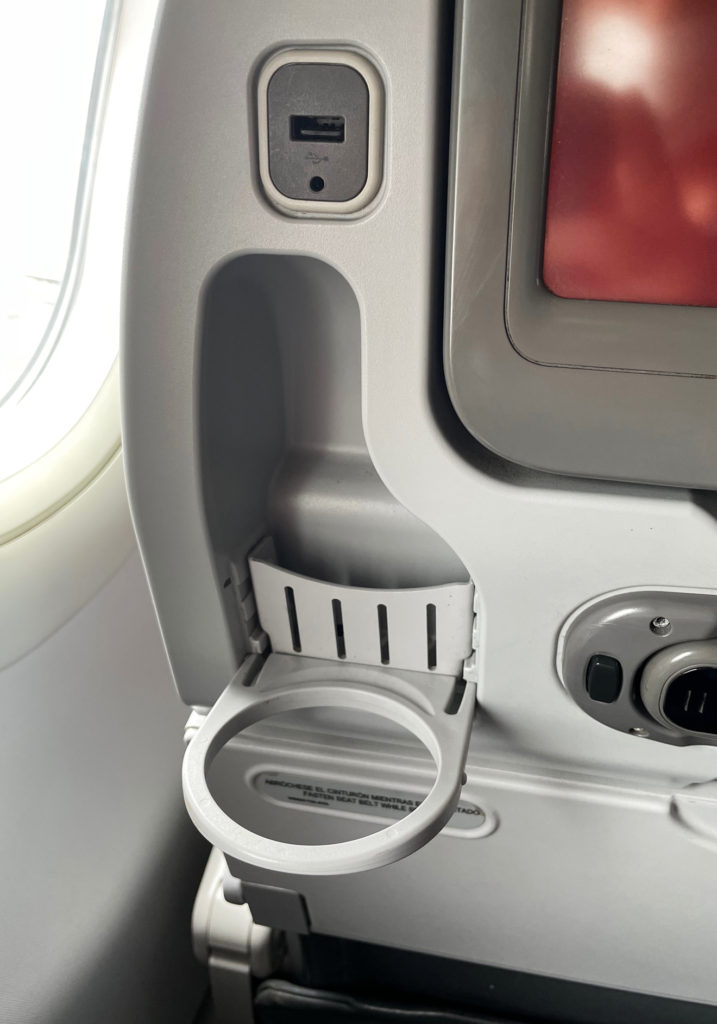
This photo was taken last week aboard an Avianca flight in Colombia. The plane was an Airbus A320, on a quick internal hop from Santa Marta to Bogota. One sees these nifty devices on foreign airlines all the time, but virtually never on American ones. Why? It’s nice to have your beverage there in front of you without having to deploy the entire tray. There’s more room to move around, and getting in and out of the seat is easier. As a bonus, you can use the thing as a hook for your headset cord or earbuds. The one above even has a little nook behind the ring, to store your milk and sweetener.
Speaking of trays, notice how the one shown is hinged in the middle, allowing you to deploy it only halfway, giving you additional space, if you want it. Another useful idea.
I know, I know, of all the things to complain about. And airlines, rightly, put the bulk of their cabin investments elsewhere. But considering the minimal costs involved, why the hell not? These are not expensive amenities.
June 22, 2021. Flashback.

For some of us, few things get the nostalgia flowing like vintage airline advertisements. This one is from Gourmet magazine, of all places, in 1976.
There’s a lot to pull from here…
For starters, looking at the collage of tails, we spy three classic carriers that no longer exist: Sabena, Swissair, and of course Pan Am. Of all the many airlines that have gone out of business, few were more historically significant than these three.
The ad also celebrates the advent of the Boeing 747SP — the short-bodied, long-range 747 variant that debuted in the mid-1970s. This focus on aircraft type is a hallmark of older ads and something rarely seen any more. When was the last time an airline spent advertising dollars to boast about a particular plane? It made sense in the 1970s, when models were vastly different from one another and some, like the 747 or Concorde, were media stars. Nowadays, with jets so tediously similar, carriers don’t bother and passengers couldn’t care less.
With that in mind, notice that every tail in that panel except for one features a 747. The single exception is the Aeroflot image, which shows an Ilyushin IL-62. These were the days when you could be at Kennedy Airport and watch ten or more 747s take off in a row.
And, of course, the whole premise of the ad — Iran Air showcasing a new link between Tehran and New York — is itself striking. How things change. Iran in 1976 was still three years away from its revolution, and the country’s national carrier was a regular visitor to New York.
Neither did they shy away from including an El Al tail (top row, third one in) up there with the others. This implies that El Al offered a connecting service to Tehran from New York, presumably via Tel Aviv, which is maybe the most remarkable aspect of the entire page.
I visited JFK in June of 1979, when I was a seventh grader. I remember standing in the rooftop parking lot of the old Pan Am terminal and looking down at an Iran Air 747. (In a box somewhere at my parent’s house, a photo of that plane might still exist, snapped with an old Kodak pocket camera loaded with 110 film.) This was immediately after the revolution began, but about five months prior to the infamous hostage crisis that helped sour US-Iran relations for the next forty years and counting.
Plenty of vintage ads take us back, as the saying goes. The best of them also take in a little history, culture, and geopolitics along the way.
June 3, 2021. Supersonic Hoopla
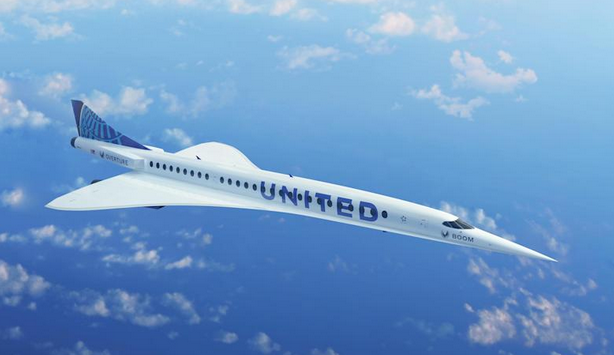
The future, or just a fantasy?
On Wednesday, United Airlines put out teasers about an important announcement to be made early the next day. Nobody seemed to know, and I went to bed wondering. Are they buying jetBlue? Are they launching another slew of long-haul routes to Africa? Are they reversing course on that abominable new livery?
The answer, which left me more than a little bemused over my coffee on Thursday morning, is a proposal to purchase up to 50 supersonic airplanes from an upstart manufacturer called Boom. The plane, under development, is intended to be a net-zero carbon-emission aircraft, and will run on 100 percent sustainable aviation fuel. It’s slated for test flying by 2025 and entry into commercial service by 2029. United will take 15 of them, with orders for up to 35 more.
The travel blogs were instantly abuzz with the news, as was the mainstream media. Which is maybe the whole point? Not to spoil the party, but the whole thing reminds me of the time in the late 1960s when Pan Am began selling tickets to the moon.
Okay, it’s not quite as far-fetched, but this is perhaps more of a publicity stunt, or a ham-handed attempt to inflate Boom’s stock price, than a hard and fast plan. Ordering a yet-to-exist supersonic plane is a lot more of a Hail Mary than, say, leasing some additional 787s, and the timeline that United and Boom have put out there is optimistic at best — assuming it happens at all.
Not that there isn’t a market for such a machine, if the costs, and subsequent fares, can be kept within reason. New York-London, Los Angeles-New York, Los Angeles-Tokyo; any number of pairings could support such a service. Potentially. Maybe. Possibly. Define “within reason.” You’re essentially cutting flight times in half. Are enough high-end passengers going to shell out thousands more to fly somewhere in three hours instead of six? Long-haul, premium-class travel is already exceptionally luxurious. How much are those saved hours worth?
And keep in mind, there’s a reason why commercial aircraft today — even the most expensive and most sophisticated ones — travel at more or less the same speeds as they did 50 years ago. Supersonic planes are vastly different than the subsonic kind, and the border between subsonic and supersonic is not an aerodynamic triviality. In a poor man’s version of Einstein’s speed-of-light conundrum, the required energy increases dramatically as you near the threshold. This requires some intensely serious engineering and, one way or the other, lots of fuel. That the Concorde, which took billions to develop, looked nothing like any other plane, was more than a quirk of design, as were its ghastly operating costs. And despite all of its promise, only two carriers ever took delivery of one.
More power to Boom, so to speak. But it won’t be easy.
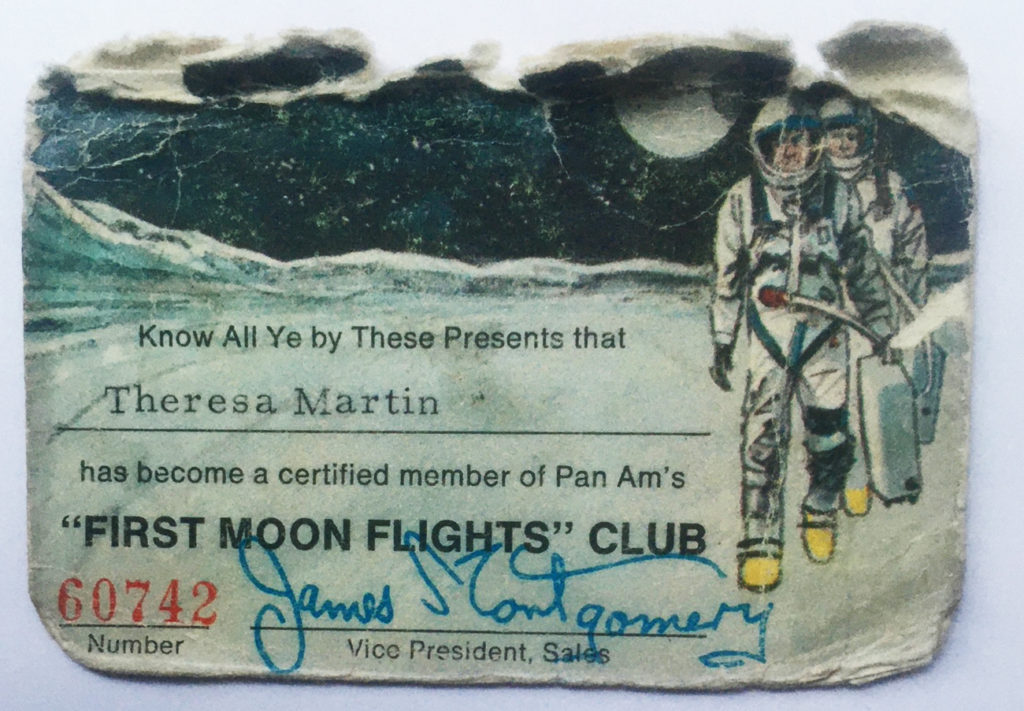
March 15, 2021. What You Wish For.

From the department of “What Was I Thinking?” I found this in my notes. It’s from August, 2019. I will add no commentary because it speaks for itself. It was something I jotted down with the intent of using later in a posting. That later turns out to be now, albeit in a context I never, ever anticipated…
I’m tired, jaded, frustrated. And if this summer is any indication, I think maybe we’ve stretched this aviation thing as far as it can go. Have you been to an airport lately? The crowds are glacial, the noise levels are insane, the lines and delays are eternal. My flight the other day from Boston to New York — a 35-minute hop — was delayed for four hours because of “flow control” into JFK. And heaven forbid a thunderstorm or two roll in. Our airspace is so super-saturated that the slightest meteorological ripple throws the entire system into anarchy.
As I type this I’m sitting in a terminal at Amsterdam’s Schiphol airport. There are so many people here, surging through the concourses, that you can hardly see the floor — a great, languid river of miserable-looking, stressed-out humanity. Where is everybody going? And why?
“Final boarding for Kigali.” KLM has a nonstop — an Airbus A330 no less — to Kigali, Rwanda, among dozens of other far-flung places. I love traveling, and I wish that I was stepping onto that very flight, right now. Just the same, I have to ask: are there really that many people who need to travel from Europe to Rwanda? Is all of this moving around necessary? All of these people — the innumerable businesspeople; the throngs of college kids with their hoodies and backpacks; the families with infants and the half-dead folks in wheelchairs — constantly on the move, by the tens of millions each week, across entire oceans and continents. In the old days people migrated. Today they simply churn.
For me there’s a troubling paradox: The more I travel, the more I see a system at its breaking point, and the more I’m of the mind that people ought to be staying the hell home.
February 27, 2021. Engine Failure.
Knock on wood, but in all my years of commercial flying, I’ve never experienced an engine failure.* Lord knows I’ve seen enough of them in simulators, but never one for real. I’ve been flying commercially since 1990, so that should give you an idea of how infrequently engines malfunction.
Should it ever happen to you, take comfort in knowing that all commercial planes are certified to fly with a dead engine. This includes the ability to climb away safely should a failure happen even at the moment of liftoff. Any engine failure is considered an emergency, but rarely if ever will it result in a crash.
When an engine does cease running, the process is usually undramatic. Passengers may not even notice. Other times, failures are accompanied by compressor stalls that result in loud bangs and even tongues of flame.
And then you have the kind in which the damn thing flies into pieces. This is the one we call an “uncontained” failure. Here, high-speed shrapnel from the engine’s internal fans, shafts or turbines, exits the cowling (the protective shell that surrounds the engine) and, in some instances, penetrates the wing or fuselage. Uncontained failures are rare, but they can be dangerous.
This was the misfortune that befell United Airlines flight 328 last Saturday. No doubt you’ve seen the cell phone footage, which, as these things go, enjoyed its fifteen (and then some) minutes of fame on YouTube and the major networks. I have to admit, the video is startling.
The engine involved was a derivative of the popular Pratt & Whitney series 4000 turbofan. It is believed that one or more of the engine’s forward fan blades, which in this particular variant are of an unusual, hollow construction, broke apart. The resulting imbalance destroyed the engine and tore the entire cowling off, leaving the powerplant’s innards scarily exposed to the full view of passengers (and, later, the rest of us).
This was at least the third similar incident, and the FAA quickly issued a so-called Airworthiness Directive, mandating inspections on all existing models of this engine. More than 120 Boeing 777s were grounded worldwide.
Although debris did penetrate the lower wing of flight 328, which was headed from Denver to Honolulu with 241 people aboard, there was no cabin breach or serious damage beyond the ripped-up engine itself. Nobody was hurt. The exciting visuals aside, getting the plane safely back to Denver would have been relatively easy for the crew. Planes maneuver quite well on one engine. While this was no ordinary day at the office, it was nothing they wouldn’t be expected to handle.
It could have been worse. In 2018, a passenger was killed after engine shrapnel took out a cabin window on a Southwest Airlines 737. In 1989, the center engine of United Airlines flight 232 disintegrated and knocked out all of the DC-10’s hydraulic systems, resulting in a crash at Sioux City, Iowa, that killed 112 people. The uncontained failure that struck a Qantas flight in 2010 nearly caused a worse disaster.
Such is the inherent danger when dealing with jet engines, which are essentially an interconnected series of fans and turbines rotating at tremendous speeds and tremendous temperatures. Fortunately, these same engines are astonishingly reliable and seldom do things like this happen.
* One day in 1999 I was the second officer on an old DC-8 freighter going from Cincinnati to Brussels. Just as we were “coasting out,” as it’s called — entering the oceanic portion of the flight — a light flickered on indicating a fire in engine number three (the DC-8 had four engines). When I say “flickered” I mean it literally. The light blinked on, blinked off, blinked on, blinked off. Nothing else was abnormal, and none of us believed there was actually a fire. Knowing this antique barge of a plane all too well, we suspected either the sensor was faulty or the bulb itself was on the fritz. We were later proved correct, but we had no choice but to shut down the engine and divert. You can’t simply ignore and engine fire warning and head out over the Atlantic. So we followed the checklist and secured the motor. Then we went to Bangor and had lobster rolls.
PASSENGER KILLED ABOARD SOUTHWEST FLIGHT
January 13, 2021. Airport News.
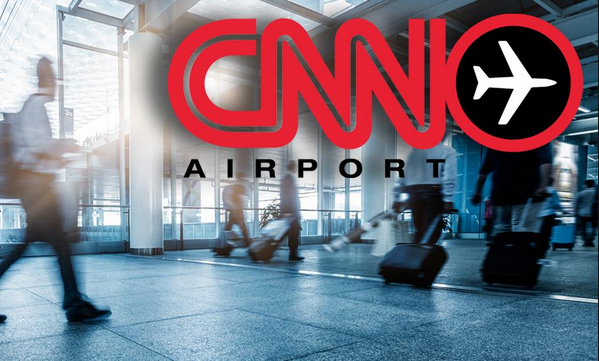
I knew there was a nugget of goodness buried somewhere in the destruction wrought by COVID-19.
Praise heaven, after thirty long and noisy years, CNN Airport News is going off the air. That’s right, effective March 31st, those infernal gateside monitors are shutting down. In a year with almost no positive news whatsoever, this one gets a gold star.
Few things are more offensive than those yammering hellboxes, hung from the ceiling in every nook and cranny of the concourse, blaring twenty-four hours a day. There is no volume control, no power cord, no escape. Not even employees know how to shut them up (I’ve asked). This isn’t a knock against the content of CNN or any other channel (I’ve been a guest on the network many times). It’s simply a plea to be left alone. Maybe if the damn things weren’t so pervasive I’d feel differently. But they are. You can’t get away from them. They took a somewhat useful idea and vastly overdid it, aggravating untold millions of people in the process.
At one point, some well-intended folks came up with a device called TV-B-Gone, a kind of universal remote that hooked onto your keychain and would silence the “chattering cyclops”* with the push of a button. They mailed me one, and lo and behold it worked… until CNN caught on and installed a blocking device. All hope seemed lost.

And the intent was what? Three decades of noise pollution masquerading as “news” has not kept passengers entertained or better informed. What it’s done is make an already stressful and nerve-wracking experience that much worse. So, good riddance. If it were up to me, the day those TVs fall silent would be declared a national travel holiday. Let us gather ’round the podium and savor the quiet.
Maybe. I hate saying it, but this feels a touch too good to be true. Those monitors and their wiring comprise an awful lot hardware, and, much as I’d love to watch it happen, I just can’t envision it all being torn out and thrown away. Will another network swoop in and take over? Fox? MSNBC? The Trump Travel Channel? I sincerely hope not. I know these things help pay the bills, but there has to be a better, more civilized way. Fingers crossed.
Related Story:
TERMINAL RACKET
November 16, 2020. Around and Around.
Go-arounds, missed approaches, aborted landings. Call them what you will; on Sunday, for the third time in my life, I was on board a plane that made two of them consecutively.
The first two times I was at the controls. In 1991 I was flying a 15-seater into Hyannis, Massachusetts, when twice the plane in front of us failed to clear the runway in time. Then, in 2008, I was flying a 757 landing into La Guardia when ATC twice misjudged our spacing on approaches to runway 22.
This time I was a passenger. I was in row 12, on a regional jet landing in Detroit. The winds were gusting to fifty knots, and the approach had been unusually turbulent the whole way down. I could see the treetops doing pirouettes. At about 500 feet the engines revved, the gear came clunking into the wells, and up, up, up we went. Whether it was crosswind issues or shears from the gusts — or both — I never found out, but something made the approach unstable enough to discontinue. The pilots did what they were supposed to do: break it off and go-around.
The second try was a carbon copy of the first one, and I was a little surprised when the captain let us know we’d be circling around for attempt number three. I assumed, after two good efforts, we were headed for Chicago or Cleveland. This time, he explained, we’d be switching to a different runway where the crosswind component wasn’t as strong. Still, I wasn’t optimist. From the window I watched the branches bending and the water rippling madly across the lakes and ponds, waiting for that tell-tale upward pitch and surge from the engines. Except this time it didn’t happen. We settled gently over the threshold and, plunk, we had arrived. The passengers broke out in applause.
Go-arounds can be abrupt and noisy, scaring the daylights out of customers. For airplanes, however, the transition from descent to ascent is perfectly natural, and a maneuver that pilots practice all the time. For more, see here.
November 11, 2020. With Sam in Dubai
Three friends and I were vacationing in Dubai last week. In the lounge of the J.W. Marriott we ran into Sam Chui, aviation gadabout and airplane photographer extraordinaire. Sam was kind enough to join us for drinks and hors d’oeuvres.
If you’re an air travel nerd, chances are you know exactly who Sam Chui is. The rest of you can familiarize yourselves with his work here. I’ve been an admirer of his photography — and sorely jealous of his luxury travel experiences — for the past twenty years.
The crazy thing is, we’d been talking about Sam Chui earlier that day, with Itamar and Karim both doing hilarious impersonations. Suddenly, that evening, he’s sitting there in the lounge.

June 3, 2020. Back At You.

Air China 747 at Kennedy Airport. Author’s photo.
Fallout from COVID has touched off a political spat between the United States and China over the resumption of commercial airline service. Effective June 16th, Chinese airlines will be blocked from serving any U.S. city.
This comes in response to China’s refusal to allow United Airlines and Delta Air Lines to restart flights into Beijing and Shanghai, intended to begin on June 1st. The reciprocal ban may take effect sooner than June 16th if the Trump administration chooses.
China says its decision was made to prevent COVID-infected travelers from entering China from U.S. cities. Yet its own carriers have been operating to and from those same destinations, including New York and Los Angeles, for the past several weeks.
Of the U.S. majors, United has the largest presence in China by far, followed by Delta and American. United also flies multiple routes into Hong Kong, which is not subject to the bans.
American carriers affected: United, American, Delta.
Chinese carriers affected: Air China, China Eastern, China Southern, Hainan Airlines, Xiamen Air, Sichuan Airlines.
Not affected: Cathay Pacific (Hong Kong), China Airlines (Taiwan).
It is unclear if or how cargo service will be impacted. U.S. airlines have been flying regular cargo charters into China, generating badly needed revenue.
Who knows how long this drama will play on. How strange it is, in the meantime, for there to be no scheduled air service between the United States and China. Then again, what isn’t strange these days? In normal times the cessation of flights between the two most important countries in the world would be a huge story unto itself. Today it’s just a footnote.
UPDATE: Two days after this story ran, China backed down and announced it would allow American carriers to once again serve Chinese cities. Flights to Beijing and Shanghai should resume shortly.
April 28, 2020. Open Spaces.
In normal times, the nation’s airport terminals are among its most uncomfortable public spaces: crowded, claustrophobic, and noisy to the point of assault, filled with the racket of screeching kids and public address announcements. You would think, therefore, that a stroll through an airport in the throes of COVID-induced isolation would be a pleasant one — a chance for those few remaining travelers to savor some peace and quiet.
But for me, during a couple of recent airport visits, that’s not how it happened. I didn’t feel any sense of solitude or relaxation. What I felt was shock and horror: the full crush of the COVID fiasco manifest through desolation and emptiness. If you want an idea of just how massively this crisis has impacted commercial aviation, behold the airport in April, 2020.
Last week in Boston, on what ordinarily would be a busy Thursday evening, I walked from Terminal A to Terminal C. I did not see another person. Neither a passenger nor an employee. A few days later I found myself standing in the check-in lobby at JFK’s Terminal 4, gazing across row after row of empty kiosks and counters. Again, not one other person in view. It was eerie, haunting, and, from this employee’s perspective, terrifying. How any airline will survive this is beyond me. I took some pictures:
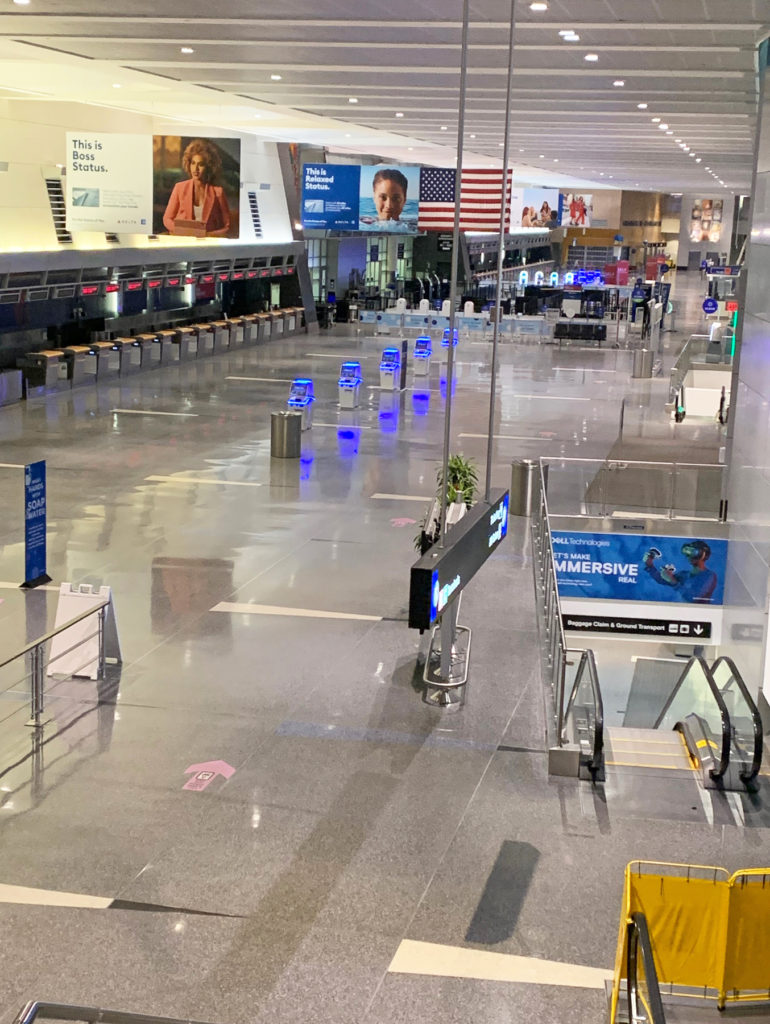
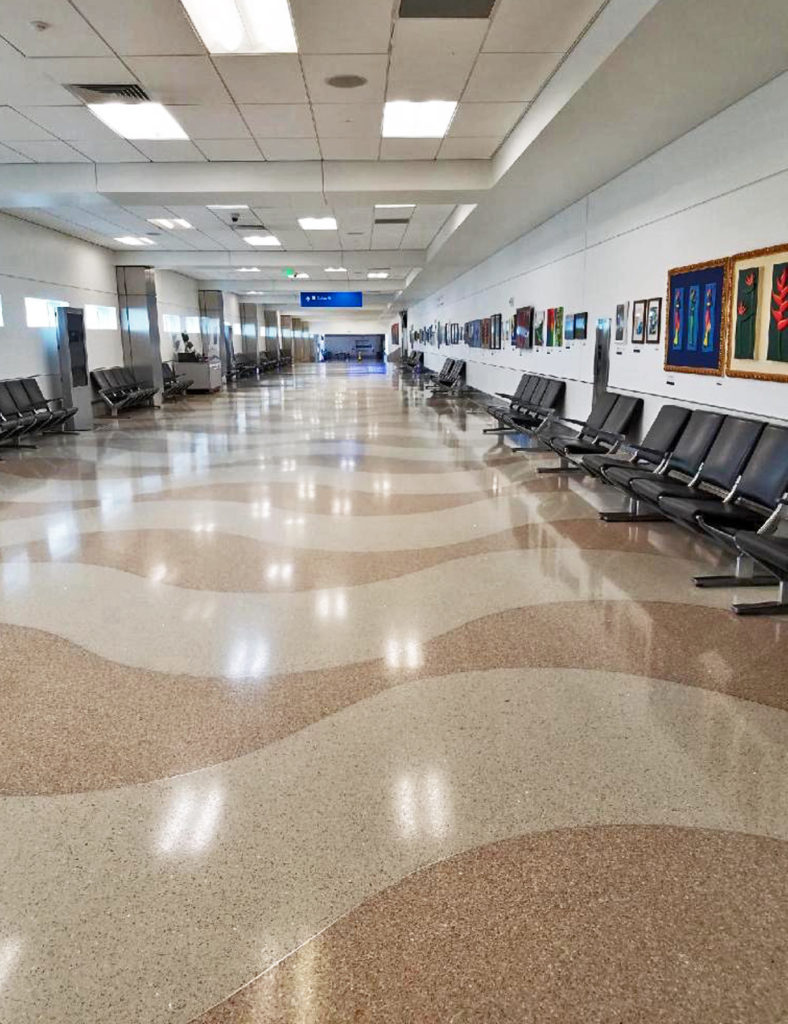

December 5, 2019. Avianca at 100

Gateside cake and pictures this morning at Kennedy Airport as part of Avianca’s 100th birthday celebration. The Colombian national carrier began flying on December 5th, 1919, and becomes only the second airline in the world to record a hundred years of continuous operation. KLM was the first, hitting the century mark back on October 7th of this year (see post further down).
Avianca was initially established as a joint German-Colombian venture under the name SCADTA (Sociedad Colombo-Alemana de Transportes Aéreos). The Avianca name (Aerovías Nacionales de Colombia) was adopted in 1940.
Photo by the author.
November 5, 2019. Et Tu, Gary Shteyngart?
Not long ago, in a complaint about the hellish proliferation of so-called spinner bags, I wrote of my disdain for use of the term “roller boards” in describing wheeled carry-ons. I’ve been hearing this sloppy mispronunciation more and more, usually from flight attendants: “Ladies and gentlemen, please place your roller boards into the bins handle-first.”
My what? We picture a wooden plank with wheels on it. What they’re attempting to say, of course, is roll-aboard. It’s a carry-on with wheels; you roll it aboard. This shouldn’t be difficult.
For a flight attendant to mess this up is one thing, but I’m shocked to discover one of my favorite novelists, Gary Shteyngart, has gotten into the act. In the opening pages of his latest book, Lake Success, the main character, Barry Cohen, is described hauling a “rollerboard” around the Port Authority Bus Terminal. Shteyngart has stylized it, turning it into a compound word, the casual-ness of which makes it even more annoying. He repeats it several times.
Few writers are funnier than Gary Shteyngart, and as one of his biggest fans, anger is about the last emotion I expect to come boiling up as I read. Yet every time that word appears I want to slam the binding against the hard edge of my desk. What the fuck, Gary? It’s roll-aboard!
Did his editors do this? Did he argue and lose? Or is there some irony or subtle meaning going on that I’m too tone-deaf to detect? No, I don’t think that’s it. Like everyone else he’s simply mis-hearing the term and not thinking about it. “Rollerboard,” meanwhile, has just enough of the right sound and meaning to be plausible, sort of (even if it’s completely stupid).
A part of me wants to believe that the author has done this by design, to annoy me. Allow me to explain…
Back in 2012, the New York Times published a funny but rather caustic piece by Shteyngart about a bad experience he’d had with American Airlines. Taking things much too seriously (imagine!), and probably desperate for something to write about, I authored a rebuttal that the good people at the Daily Beast were kind/bored/pitying enough to run. The rebuttal was a masterpiece of the kind of stick-up-his-butt humorlessness that only I could create. My conspiracy theory holds that Shteyngart remembered this, and “rollerboard” is his way of getting even.
Yeah, I know: like he’s ever heard of me, saw my spinner bag post, or would possibly give a shit enough to grammatically sabotage his own novel as part of some demented shout-out to a blogger.
But it’s fun to think about.

October 18, 2019. Airlines by the Numbers.

This picture was taken not long ago at Bangkok-Suvarnabhumi (BKK). It shows 66 carriers serving the airport. That is, one must admit, a lot of airlines. And it got me wondering: which airport has the most? Is it Bangkok? Heathrow? De Gaulle? JFK? I’m too lazy to research it myself, but maybe there’s a reader up to the challenge.
It’s not as easy as it sounds. What about regional carriers operating in the colors of a major affiliate? They can be hard to keep track of, and an argument can me made they shouldn’t count. Subsidiaries and alter egos, too, are a gray area. Notice the BKK placard has “Thai Smile Airways” at number 59. That’s just the short-haul leisure division of Thai Airways, which sits right above it at 58. Does it deserve a slot of its own? Is Air Canada and Rouge the same thing? Air France and Joon? Is it the name or the livery? And how about nonscheduled carriers that sometimes pay a visit? Each case, maybe, deserves its own judgment call.
Or, how about any name with its own IATA or ICAO code, regardless of the paint job or affiliation?
At BKK I would kick Thai Smile off the list, seeing that is shares Thai Airways’ “TG” IATA tag. Also, India’s Jet Airways, number 32 on the sign, has since gone bust. That puts the Bangkok total at 64. Let’s start with that and see who can beat it.
As a bit of an aside, I’m a little startled that no American carrier flies to Bangkok. Delta and United, both which served the city for several decades (dating back to the Pan Am and Northwest routes those carriers inherited), recently pulled out. I realize that Thailand isn’t an easy market. It’s half a world away, and primarily a leisure destination with low yields and, as that sign attests, loads of competition. Still, the sheer number of Americans that visit the country — roughly a million each year, or 2,700 a day — convinces me there’s a way to make it work.
October 7, 2019. Dutch Centenary.

It’s been fun over the past several months seeing the proud “100” decals on the side of KLM’s Boeings and Airbuses. KLM Royal Dutch Airlines is the oldest airline in the world, and on October 7th it will celebrate its one-hundredth birthday. It’s hard to imagine, but the airline that today can take you to Jakarta or Quito or Mount Kilimanjaro in a state-of-the-art jetliner, is the same airline that once ferried passengers, seven at a time, across the English Channel in a rickety Fokker made of wood and fabric. As part of the celebration, three of KLM’s Monday arrivals at JFK will be given a water cannon salute.
The letters KLM stand for Koninklijke Luchtvaart Maatschappij, which in English means Royal Aviation Company. But you knew that.
Airline genealogies can be complicated. Many carriers have changed names and identities or have blurred their pedigrees through mergers and acquisitions. Here are the seven oldest majors flying under their original monikers:
• KLM (1919)
• Qantas (1920)
• Aeroflot (1923)
• CSA Czech Airlines (1923)
• Finnair (1923)
• LOT Polish Airlines (1928)
• Delta Air Lines (1928)
If we allow for name changes and mergers, Colombia’s Avianca would be up there at number two, having started out in 1919 as something called SCADTA. It’s a shame to see Mexicana (previously in third place) gone from the list. The airline ceased flying in 2010 after eighty-seven years.
If you’re surprised that places like Mexico, Colombia, Russia, or Australia have such a long aviation heritage, remember that rugged terrain, lack of roads, and vast distances made these countries natural spots for aviation to take hold.
KLM photos by the author.
October 3, 2019. Word Shapes.
I want to know more about the Emirates typeface — the lettering the airline uses in its marketing, advertising, and so on. Who came up with it? Does it have a name? What is it meant to evoke?
It looks like this…

Or like this, as seen on a first class menu…

Typeface design has always been part of a carrier’s branding, but I’ve never seen an airline use a proprietary font with such devotion. At Emirates it’s everywhere: on the side of the plane, in its promotional literature, and on virtually every printed sign or notice. I was in the Emirates lounge in Johannesburg the other morning and even the little buffet placards used it.
It’s handsome and ultra-distinctive, with just a dash of — what can we call it? — exotic flair. Notice how the jaunty cant of the lowercase “e” and “a” synchs with the airline’s calligraphic logo. It’s a subtly powerful tool for communicating the Emirates identity, and I wish more airlines did this sort of thing.


Photos and thumbnail composite by the author.
August 16, 2019. Feathers and Fate
In chapter six of my book I talk about some of the scenarios pilots fear. This pilot, at any rate. They’re generally not things the traveling public would expect. A tire burst and takeoff abort at high runway speed, for example. Or a lithium-sparked cargo fire. Or birds.
Bird strikes are common, and the damage tends to be minor or nonexistent — unless you’re looking at it from the bird’s point of view. And as you’d expect, aircraft components are built to tolerate such impacts. I’ve personally experienced several strikes, and the result was, at worst, a minor dent or crease. I should hardly have to mention, however, that strikes are occasionally dangerous.
This is especially true when engines are involved. Modern turbofans are resilient, but they don’t take kindly to the ingestion of foreign objects, particularly those slamming into their rotating blades at high speeds. Birds don’t clog an engine but can bend or fracture the internal blades, causing power loss. The heavier the bird, the greater the potential for harm. Flying at 250 knots—in the United States — that’s the maximum allowable speed below 10,000 feet, where most birds are found — hitting an average-sized goose will subject a plane to an impact force of over 50,000 pounds. My big fear is such an impact causing power loss or engine failure at or near takeoff speed, requiring a high-speed abort. No less scary would be the same thing happening just after takeoff, potentially resulting in an off-airport landing or a crash.
That’s exactly what happened in 2009 when US Airways flight 1549 glided into the Hudson River after colliding with a flock of Canada geese. And, on Thursday, it happened again. Ural Airlines flight 178, an Airbus A321 with over two-hundred people aboard, went down seconds after takeoff from Moscow’s Zhukovsky International Airport. Mobile phone footage shot by passengers shows the jet colliding with a flock of seagulls as it becomes airborne. The impact severely damaged both engines, forcing the pilots to glide into a cornfield just off the runway.
As with the Sully-upon-Hudson splashdown in 2009, there were no fatalities. Also in both cases, pilot skill played a comparatively minor role. It was luck, more than anything, that saved the day: daylight, clear weather, and a smooth, obstruction-free spot for the pilots to aim for.
Your next question, then, is why aren’t engines built with protective screens in front?
Well, in addition to partially blocking the inflow of air, the screen would need to be large (presumably cone-shaped) and very strong. And should it fail, now you’re sucking in a bird and pieces of metal.
June 17, 2019. Mountain Madness.

Alpaca at Machu Picchu, 1994. Author’s photo.
Your first view of Machu Picchu, the mountaintop Inca citadel in south-central Peru, is never forgotten. The scenery is almost comically dramatic — the Andean peaks and valleys as preposterously vertical as a child’s crayon rendering. It is, just maybe, the most staggeringly impressive tourist site on earth.
There are no roads to Machu Picchu. One must fly first to the regional capital of Cuzco, then travel onward by train or embark on a multi-day hike. Its remoteness, and the logistical challenges of getting there, are part of what make it such an exciting and enchanting spot. It takes some planning, and relatively few people bother. Indeed, Machu Picchu is one of a vanishing number of tourist icons that isn’t grossly overcrowded.
But if the Peruvian government has its way, this all will be changing. Ground has broken on a new airport that will permit tourists to fly directly to the ruins. Chinchero International Airport will become the nation’s second busiest, with the capacity to handle up to seven million passengers annually and a runway long enough to accommodate jets from the U.S. and Europe.
Currently about a million people per year visit Machu Picchu. That’s roughly 2,700 per day, which by global tourist standards is a small and manageable volume. The impact of a major nearby airport — the effects to the ruins themselves, and to the surrounding countryside and towns — capable of more than quintupling the number of visitors is almost too depressing to imagine.
JOIN ME IN SIGNING THE ONLINE PETITION HERE.
What’s happening in Peru, of course, is part of a wider conversation and the great tourism conundrum of our time: how do we encourage people to celebrate and savor a destination without simultaneously ruining it?
How bad can it get? Have you ever been to Amsterdam, Prague, or Barcelona in the summer? In Thailand and the Philippines, entire islands had to be closed off from tourist throngs to save them from destruction. Today, thanks in no small part to cheap jet fuel and budget airfares, one can fly nonstop from major cities across Europe, Asia and the Gulf to places like Phuket, Krabi, Ko Samui and Cebu.
As a pilot and air travel advocate, I’m generally in the business of encouraging and promoting tourism by air. But this begins to feel unconscionable when such activities run counter to the whole point of travel, undermining the very things that make it special.
February 26, 2019. The Guts of a Gust.
The big story this week has been wind. First we had an unusually strong jetstream that was pushing planes across the country, and across the North Atlantic, at record-breaking groundspeeds — as discussed here. Now, powerful low-level winds have been wreaking havoc at airports around both the U.S. and Europe.
The first thing people are asking is whether these two phenomenon are connected. The answer is not necessarily. Hey, it’s winter, and things tend to be colder and windier across the board. Certain patterns and systems do affect both high and low-altitude weather, but with wind there’s usually a pretty clear distinction between the goings on at higher altitudes and those close to the ground. Abnormally strong winds at 35,000 feet do not not, by themselves, foretell abnormally strong winds at 350 feet.
The other thing people want to know is how dangerous windy conditions can be when taking off or landing. Yesterday at airports in the northeastern U.S., gusts were topping 60 knots, causing widespread delays and cancellations. And maybe you caught the video of the British Airways A320 flailing overhead as it attempted a landing in Gibraltar before diverting to Malaga, Spain.
Most of the logistical snarls we’re seeing are due to runway alignment. Aircraft take off and land into the wind. There’s some flexibility here — crosswinds and even tailwinds are tolerable to some extent — but if the wind is blowing hard enough, certain runways become unusable. This can vastly restrict the number of arrivals and departures an airport can accommodate. That’s mostly what we’ve been dealing with. If your flight is delayed or canceled, it’s not because conditions are dangerous. It’s because of congestion.
When the wind comes at you from the side, that’s a crosswind. All planes are certified to a maximum crosswind component, and these tend to be quite high. The 767 that I fly has a max allowable crosswind component of 40 knots.* With respect to headwinds, meanwhile, it’s the more the merrier, from a pilot’s perspective. A strong headwind keeps your groundspeed low and allows you to use less runway. Rarely, though, is the wind perfectly stable or consistent from a particular direction. As anybody can feel when outside on a blustery day, it can shift around and intensify unpredictably. Seldom is this a problem; planes are surprisingly stable even in very rough air, and on landing we calculate buffer speeds to account for gusts and small shears. But, every so often, things become so gusty, and so unpredictable, that yeah, conditions can be unsafe. Powerful low-level gusts can bring on windshear or severe turbulence. On landing this can make it difficult to maintain what a pilot calls a “stabilized approach.” There’s no fixed number, in terms of miles-per-hour, when this might happen — but if an approach becomes unstable or windshear is an issue, you’re liable to find yourself diverting to another airport.
As for that British Airways video from Gibraltar, winds that afternoon were reportedly no more than about 20-30 miles-per-hour, which is fairly tame, with no significant crosswind. So why was the plane rocking back-and-forth like that? Most likely it had something to do with the famous, 1,400-foot “rock” that rises nearby. So-called “mountain waves” can form when cold, dense air spills from a peak, alternately sinking and rising again, creating significant turbulence. There’s also an unusual phenomenon called “Von Kármán vortex shedding,” whereby a mountain can spin off alternating, upward/downward whirlpools of air — vortices that may have caught the Airbus as it flew past.
* That’s right, you can land a 767 with a direct crosswind of up to 40 knots. I’ve seen this in the simulator several times, but in the real world it’s something I’ve experienced only once, about eight years ago in Madrid. I can’t remember the runway, but the wind was almost exactly 90 degrees from our left, at 35 knots. It was the captain’s landing, and he nailed it. Luckily the wind was very steady, with only a slight gust factor. Had it been more blustery, we’d probably have needed a different runway.
Related Stories:
THE BIG PUSH: THE JETSTREAM CRANKS TO ELEVEN.
AIR TRAVEL AND THE ENVIRONMENT.
September 12, 2018. Pilot Snooze.
So maybe you saw the story: a passenger on board a United Airlines flight from Newark to Glasgow was alarmed to discover the plane’s captain taking a nap in one of the 757’s business class seats. He snapped a picture and, as these things go nowadays, touched off a scandal.
Or thought he did. The pilot, it turns out, hadn’t done anything wrong.
As described in chapter four of my book, all long-haul flights carry augmented cockpit crews that work in shifts. They aren’t napping because they’re lazy. They’re napping because, by regulation, they have to.
The specs on how this works vary a bit, country to country and airline to airline (a carrier’s in-house union rules are sometimes more restrictive than the government rules). At my airline, flights scheduled to be over eight hours long, but fewer than twelve, carry three pilots: one captain and two first officers. We rotate; all pilots are in the cockpit during takeoff and landing, but each spends roughly a third of the en route portion on break. On flights greater than twelve hours we bring four pilots: two captains and two first officers, and we work in pairs. Either way, there are always at least two pilots in the cockpit at any point.
Pilots on break retire either to a bunk room — squirreled away somewhere on, above, or below the main passenger deck — or to a designated first or business class seat, usually cordoned off with a curtain.
Flight attendants, too, take required breaks and have their own separate bunk rooms (or seats) for resting.
And if you’ll allow me to digress a minute…
If I’m not tired enough to sleep, I’ll often spend my break eating dinner and watching TV or a movie. I seldom watch television at home — I don’t even have cable — and it’s through my job, oddly enough, that I came to love and binge-watch some of my favorite series: “Boardwalk Empire,” “Breaking Bad,” “Flight of the Conchords,” “Mr. Robot,” and so on. I would never have discovered these shows if not for my long-haul rest breaks.
Indeed, it was on one of those breaks that I watched what, to this day, is the most brilliantly hilarious thing I’ve ever seen on TV. I’m talking about the four-minute, Russian Tea Room scene starring Louis C.K. and F. Murray Abraham in the “Dad” episode of the show “Louie.” You can view it here.
That sequence is so consistently and intricately funny that it’s hard to pinpoint the best part. I’m especially fond of the moment when Louie, flustered and helpless, says, “That’s… that’s a question?”

August 16, 2018. Alcohol Aloft.
Have you been following the story about the woman who was jailed for having a glass of wine on an Emirates flight? After arriving in Dubai from London, 44 year-old Ellie Holman admitted to an immigration officer that she’d consumed a complimentary glass of wine during her flight, at which point the officer reminded her that alcohol possession is illegal in the United Arab Emirates. She was arrested and spent three nights in the clink before being released on bail.
Well, that’s the water-cooler version. What really happened is more complicated. The woman tried entering the UAE using an expired Swedish passport, then an Iranian passport. Reportedly she became irate when informed that her stay, per Iranian visa rules, could not exceed 96 hours. She was arrested after pulling out a mobile phone and attempting to film the immigration officer. A UAE government statement says Holman was charged not with alcohol possession, but with using profanity and photographing an official in a restricted area. The charges have since been dropped, however, and the UAE apologized to Holman on behalf of the immigration officer.
The best and most thorough explanation of the affair that I’ve seen is in, of all places, People magazine.* Few other sources, though, have bothered to elaborate. “Woman jailed for drinking on flight” is one of those scandalous little teasers that Americans love to play up and share, regardless of the details.
If people were really be arrested for drinking on flights to Dubai, the airplanes would be empty. Believe me, there’s more liquor on an Emirates 777 or A380 than you’ll find in a distillery. The A380s have an onboard bar, for heck’s sake. Make that two bars: a serve-yourself bulkhead bar at the front of first class, and a lounge in the lobby behind business class, staffed by a bartender. Departing from Dubai, champagne is served prior to pushback — on most carriers, not just Emirates — and the airport’s premium class lounges are home to several bars.

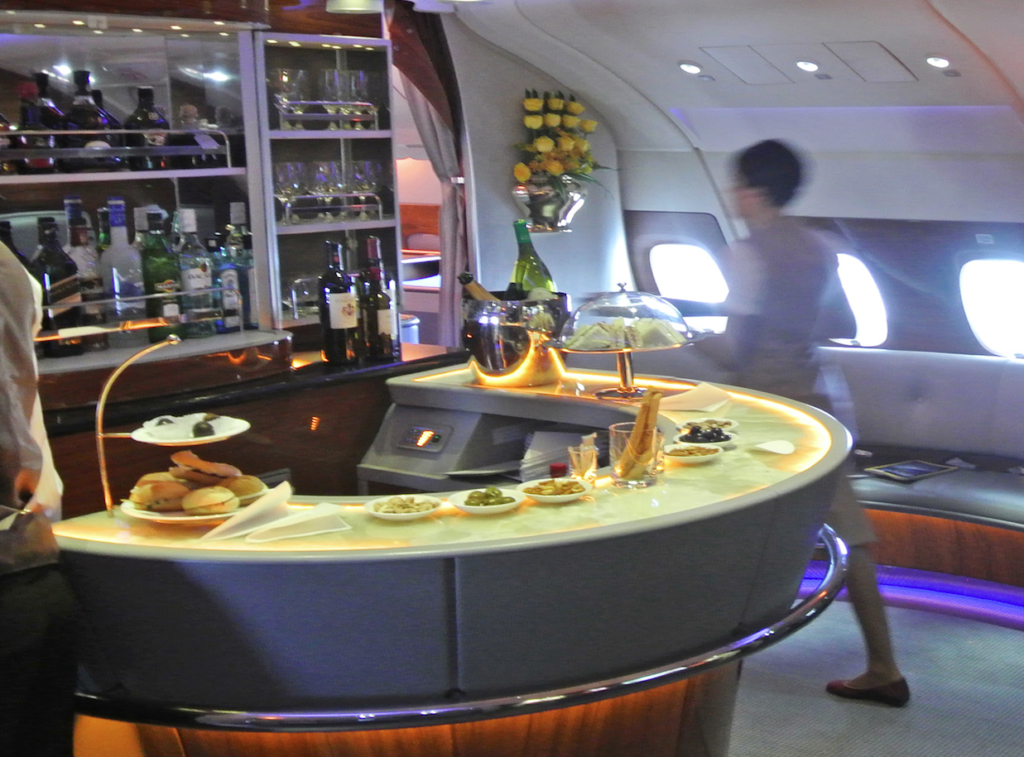

PHOTOS BY THE AUTHOR
* I need to go easy on People. They once had a picture of me in one of their issues.
April 14, 2018. Names and Places.
Here are four pictures. The first two, showing a pair of KLM 777s, I took in Amsterdam. The second two show the real things.


I dig it when airlines name their jets, and here we see some of the “crossover” that so endears me to aviation. It’s not just about planes and the act of flying. The beauty of aviation is ultimately about culture, geography and travel.
Iguazu Falls straddles the border between Argentina, Brazil, and Paraguay. The photo above was taken from the Argentinean side. I’d already been to Victoria Falls and Angel Falls, and I was expecting to be underwhelmed by Iguazu. As I hope the picture reveals, this was the wrong thing to expect. Perfect weather and light crowds may have heightened the impact, but I was blown away. What you see here is the main section of the falls. There are smaller sections scattered through the forest, and you can tour the site at your own pace along a set of wooden causeways. If you’re ever in Buenos Aires, I’d strongly recommend adding a couple of days to your itinerary and flying up to Iguazu. In BA, flights depart from Aeroparque, the domestic airport just a few minutes from downtown.
The bottom photo was taken in 1994. Machu Picchu is impressive enough that it’s one of the few places I’ve visited twice — the second time in 2003. Just be sure to arrive at the ruins as early as possible, and/or stay there until closing time. The midday crowds can be a little overwhelming.
I’ve always wanted to open a Peruvian-Italian restaurant that I could name “Macchu Pizza.”
April 1, 2018. “Cleared to Land,” “Floor Area,” and Other Public Address Nonsense.
The bombardment of public address announcements on planes is one of air travel’s most vexing discomforts, but it can sometimes be funny. Funny through the sheer madness of it. The ways in which airline workers can bend, twist, and otherwise convolute the English language is nothing if not astonishing. For reasons unknown, it is impossible for a crew member to simply say, for instance: “I am driving my car to work.” Instead, he or she must say, “At this time, I am operating my vehicle to my location of employment.” This stylistic overkill is designed, I think, to get your attention, and to make a particular statement sound extra-important. All it actually does, though, is burden your synapses by forcing them to deal with far more words than they need to. The phrasing is often so strained and heavy-handed that you can almost hear the sentences crying out in pain. Flying is tedious and stressful enough. Just get on with it already.
Some of the most humorous examples are found in my Air Travel Glossary but I keep discovering and adding new ones. The latest addition is “floor area.” You’ll hear this from the flight attendants as part of the after-landing spiel. “Please check the floor area for your personal belongings before deplaning.” Also known as the floor. Who talks like this? When you’re at home, do you say, “I need to vacuum the floor area”? Or, “Look at that, Brendan, you’ve spilled cereal all over the floor area!”
Pilots also make peculiar use of “area” during their before-landing announcement. “Folks, we’ve begun our descent into the Chicago area….” Well, yeah, I guess, but we’re not landing in “the Chicago area,” we’re landing in Chicago. What’s wrong with, “We’ve begun our descent into Chicago.” Or better still, “We’ve begun our descent.” I’m pretty sure everyone on the plane knows where it’s going.
And so on.
In the meantime, can the cabin crew please — please — knock it off with the “Ladies and gentlemen, we’ve been cleared to land…” announcement that is made during descent. I don’t know when or how this habit got started, but it’s become routine. Some airlines actually train their flight attendants to say it. The problem is, it’s not true. Actual landing clearance normally occurs within one or two minutes of touchdown — often less — and this information is not relayed to the flight attendants. They have no idea when the plane is cleared to land. The second set of chimes that you hear during descent has nothing to do with landing clearance. It’s a generic signal that means little more than, “We’ll be landing shortly.”
This is maybe something only a pilot (who is also a pedantic crank) might get upset about. Because, really, who cares and what difference does it make? But I can’t help myself.
November 19, 2017. Bumps and Bunk.
If you’re one of the millions of flyers made nervous by rough air, maybe you’ve wondered: when is the smoothest time of day to fly? Or, better still, is there a time of day I should avoid? The answer is no, not really. Turbulence is too unpredictable for such blanket cautions.
A recent online story, however, claims otherwise. First run by Business Insider magazine, and picked up again this past weekend by Condé Nast Traveler, the story features an interview with a Professor of Atmospheric Science named Paul Williams, who tells us that early morning flights are the worst, and should be avoided. “The first flight of each day on a particular route tends to be particularly turbulent,” Williams says. He recommends anxious passengers “Avoid flying the first departure from any airport on any route … because that airspace has been unexplored overnight and we generally have no idea how turbulent that atmosphere has been.” Williams explains that pilots, who often rely on reports from other aircraft to help pinpoint and avoid the bumpiest areas, have little to go on so early in the morning. “We don’t have prior knowledge from the previous flight that flew through that route,” he says.
The problem with this advice is that it’s complete bullshit. Airline meteorology departments have become very good at forecasting the where, when, and how bad of rough air, and there are plenty of reliable, real-time reports available from other aircraft, regardless of the time of day. Air travel is very much a 24/7 operation, and commercial airspace is surprisingly busy even in predawn hours. And if anything, the air tends to be slightly smoother, on average, first thing in the morning. Professor Williams claims to have spoken to pilots who back up his contention, but he obviously misconstrued or misunderstood whatever it was they told him.
Aviation can’t be an easy beat for a journalist, but this is yet another example of one turning to the wrong source. I’ve seen so many articles just like these, where instead of seeking out front-line professionals who deal with the topic as a matter of routine (a pilot, perhaps?), the reporter will instead turn to this or that professor, researcher, or other aviation academic. And time and time again their stories suffer for it. I have no doubt that people like Paul Williams are bright, well-trained, and highly knowledgable in their fields (indeed, I enjoyed watching some of Williams’s other online lectures, including one detailing the atmospheric impacts of climate change). Unfortunately, they tend to have very limited knowledge about the day-to-day realities of commercial flying. Understanding atmospheric science, and understanding turbulence in the context of airline operations, are extremely different things.
If you’re one of those nervous flyers, see my essay here, instead.
July 6, 2016. Terminal With a View.
I took these pictures in Europe recently. The first one is the observation deck at Amsterdam’s Schiphol airport (yet another of Schiphol’s numerous little conveniences). The second is a billboard for a similar deck at the airport in Zurich.
Once upon a time, every big airport had decks like these. Where they still exist, they remain popular. You don’t need to be an airplane geek to appreciate the view and a chance to escape the noise and in-your-face retail onslaught of the terminal. The ones at Schiphol and Zurich are outdoor decks, which is maybe not ideal considering the Dutch or Swiss weather, but in temperate months it’s refreshing to be outside. And, at Schiphol, it allowed them to install that old KLM Fokker 100 as part of the scenery.
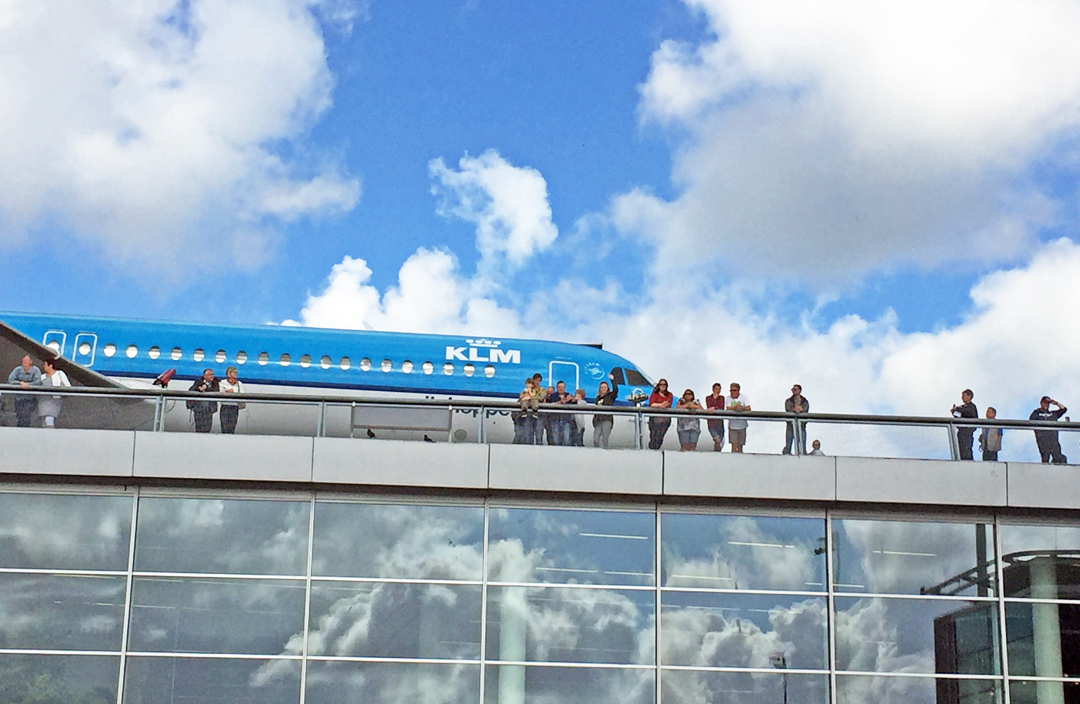
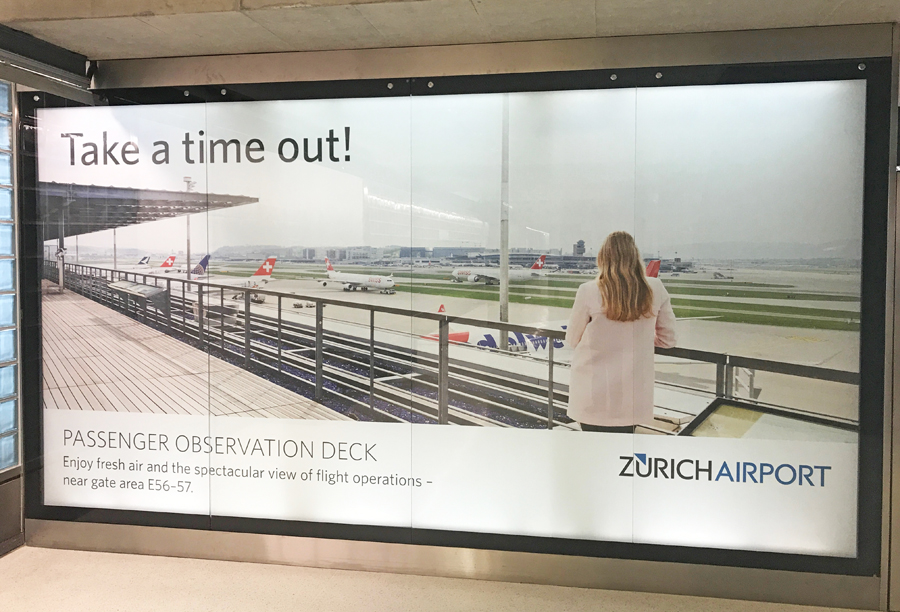
The dearth of observation decks these days no doubt ties into our obsession with security — a conversation too aggravating to have at the moment, so let’s not have it.
The greatest observation deck of all was the old 16th-floor platform in the control tower at Boston-Logan. This was my home-away-from-home pretty much every weekend from sixth grade through high school. Sadly, it’s been closed for over two decades now, converted into an operations room for the Massachusetts Port Authority. Back in the day, it featured opposing sides of knee-to-ceiling windows and the best view in town. It’s a scant two miles from Logan’s perimeter seawall to the center of downtown, and you observed the city and its airport in a state of working symbiosis. Passengers relaxed on carpeted benches while kids and families came on the weekends, feeding coins into the mechanical binoculars and picnicking on the floor. It made the airport a destination unto itself, like a park or a museum, and encouraged a kind of civic togetherness rarely seen at airports.
May 30, 2016. DXB: The World’s Megahub.
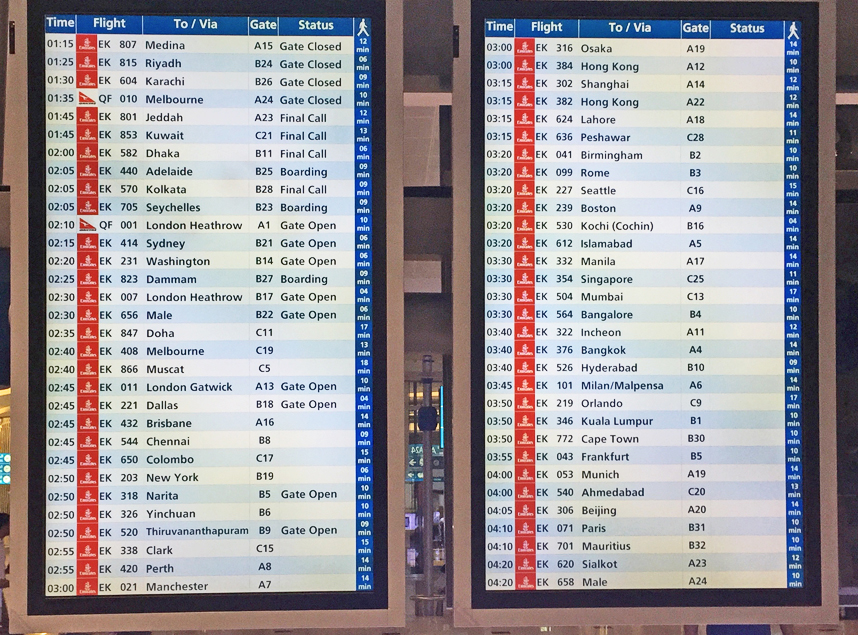
Each time that I pass through Dubai International Airport, it knocks my socks off. DXB is now the world’s biggest and busiest international transfer hub. Emirates’ massive Terminal 3 is the largest airline terminal in the world, and the lineup of aircraft is unlike anything you’ve ever seen. Try to imagine the sight of 50 or more A380s, and dozens and dozens of 777s, all parked side-by-side. Here’s a shot of the DXB departure board that will give you some idea of what I mean. This shows just a three-hour window, between 1 a.m. and 4 a.m. And keep in mind that almost every one of these departures is an A380 or a 777-300. (My flight was EK 701, seen lower right, one of Emirates twice-daily A380 departures to Mauritius.) There are flights to six continents and across every ocean. Throughout the long history of commercial aviation, nothing like this has ever existed.
The growth of Emirates and the other Persian Gulf carriers, Qatar Airways and Etihad (together they are frequently referred to as the “Gulf 3” or “G3”) has been controversial. Lavish government subsidies, many argue, have permitted these airlines to take a huge and unfair advantage over our own carriers. Is this true? Sure. But it’s also true that these airlines’ hubs — Dubai, Qatar, and Abu Dhabi — are ideally situated, geographically, to connect the world’s biggest population centers. More critically, though, the governments of these countries understand that the commerce generated by air travel is something to be nurtured rather than hindered. You can call it government subsidizing, and you can call it government investment in something that the economy and society benefits from. As a result, transferring at Dubai is a breeze: security takes about 25 seconds; everything leaves on time; everything is big and clean and fast and efficient.
Here in the U.S., our airports are undersized and dirty, security screening has gone off the rails, and consider the misery we put international connecting passengers through. You ask if the complaint of government subsidies is valid. Yes, but it’s less a complaint against their governments than a complaint against ours. Once upon a time, we were commercial aviation’s global leader. That was then.
Emirates’ advertising slogan is “Hello Tomorrow,” which sounds to me like the slogan for a theme park. They should change it to “The Airline of Planet Earth.” Because it sounds better, and because it is. (In exchange for the use of this slogan, I ask for either a million dollars or unlimited complimentary first class travel.)







